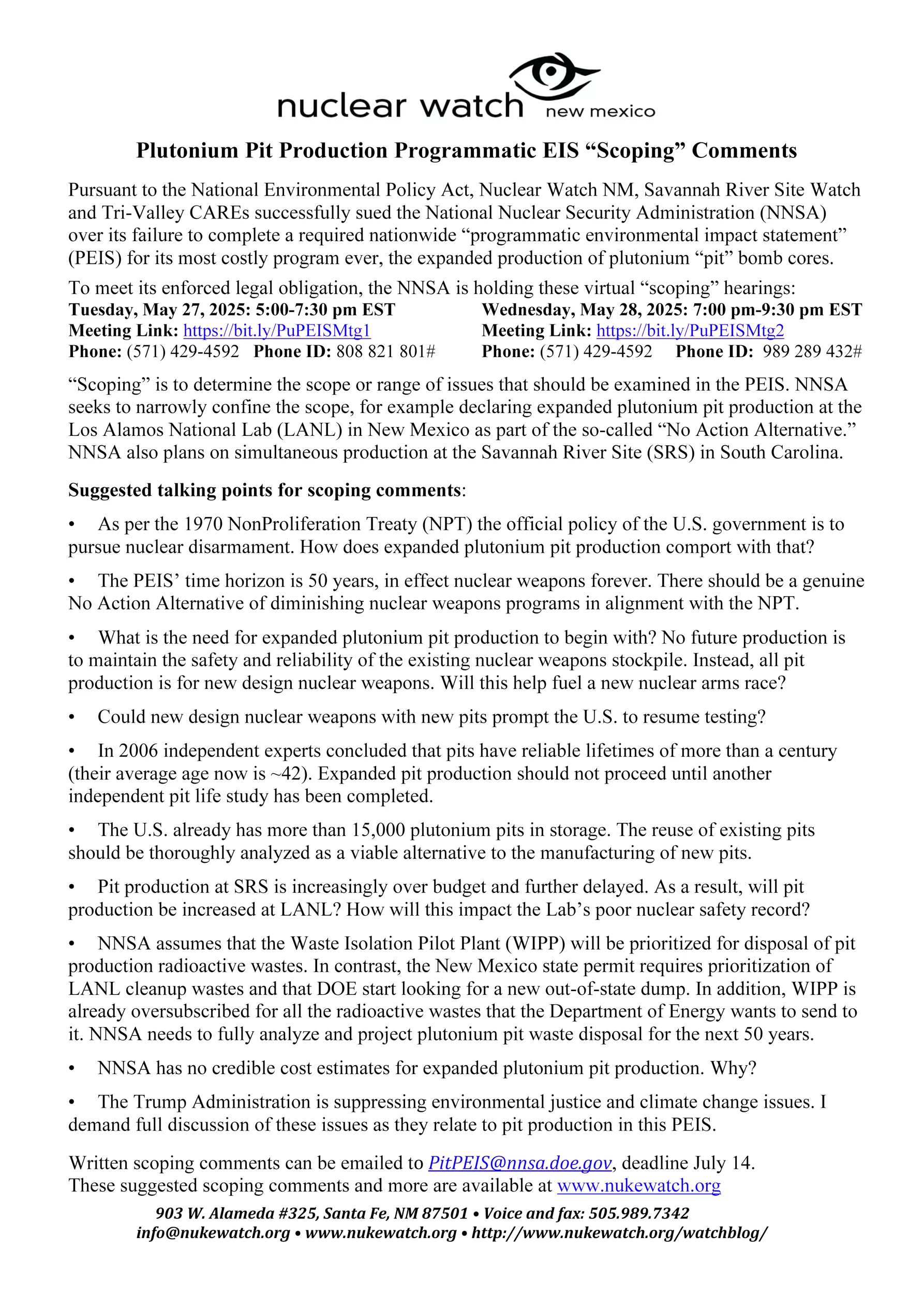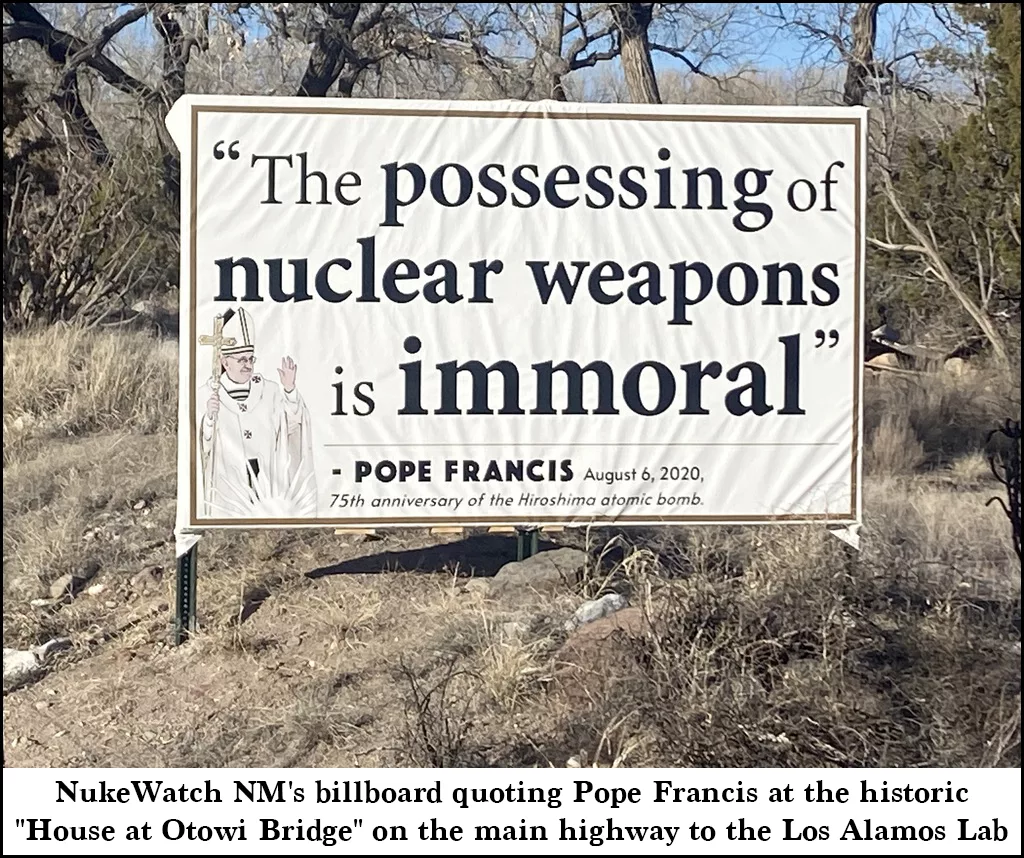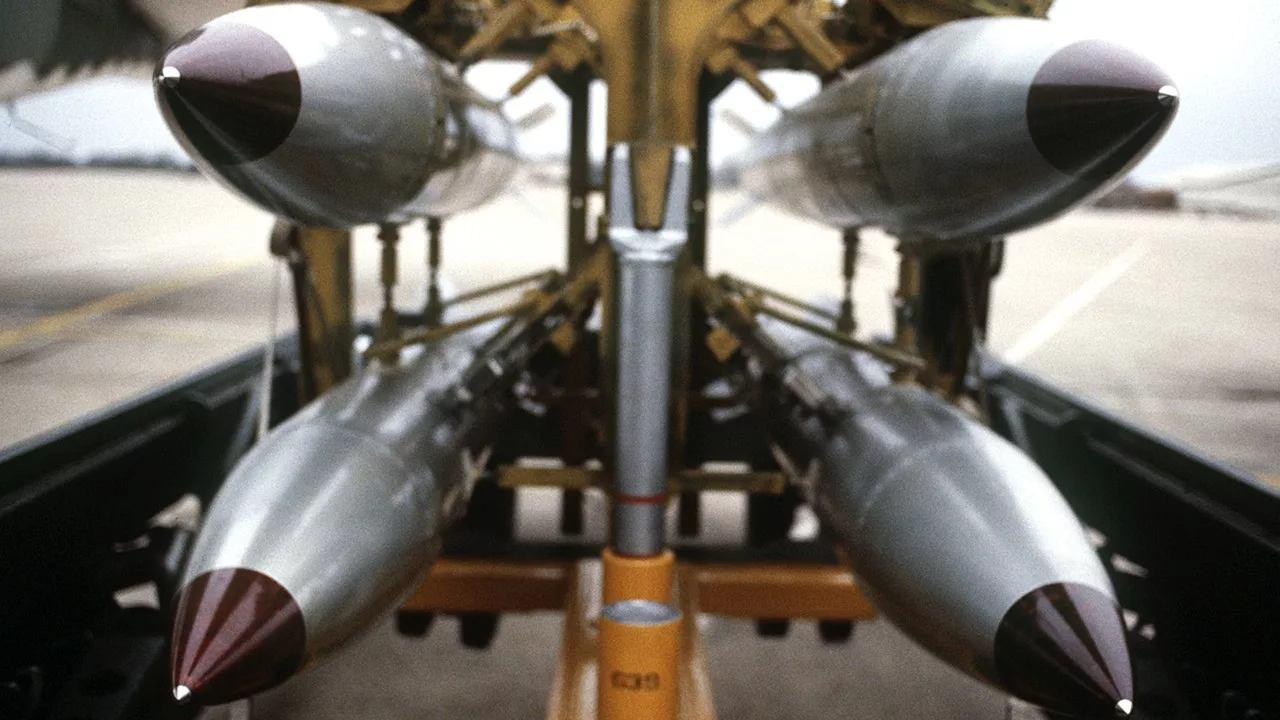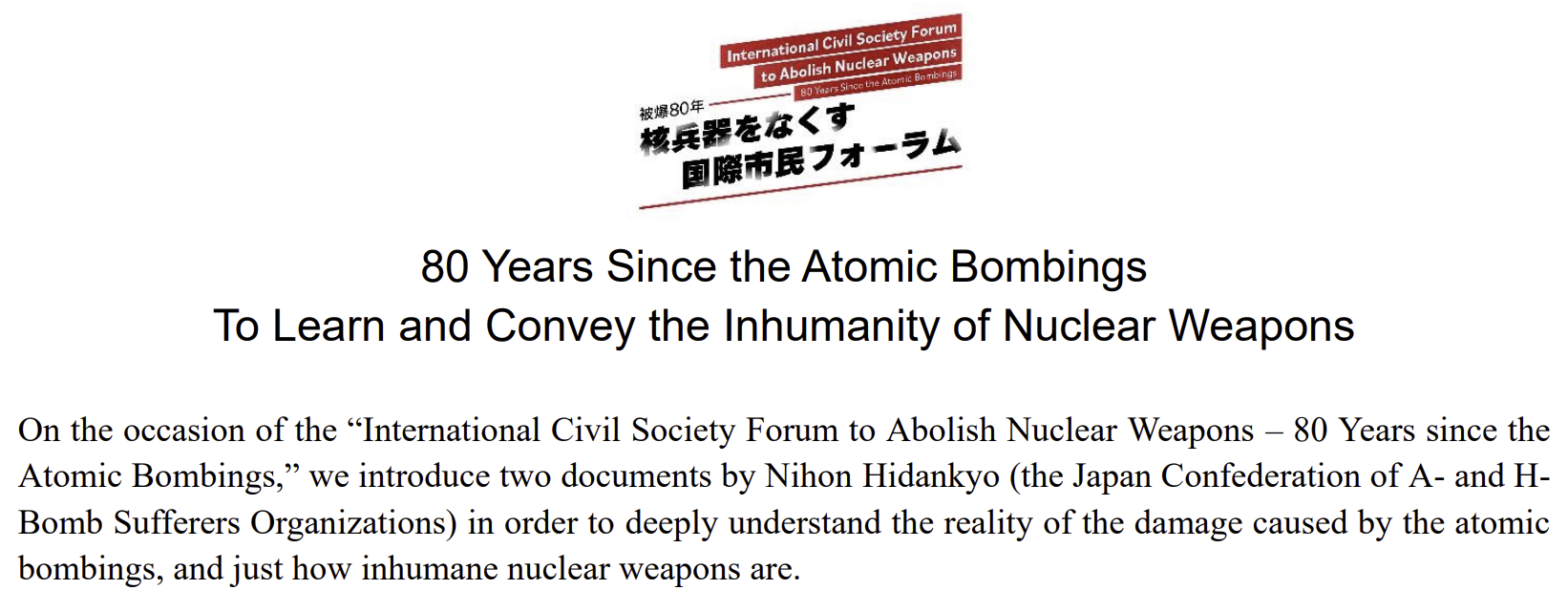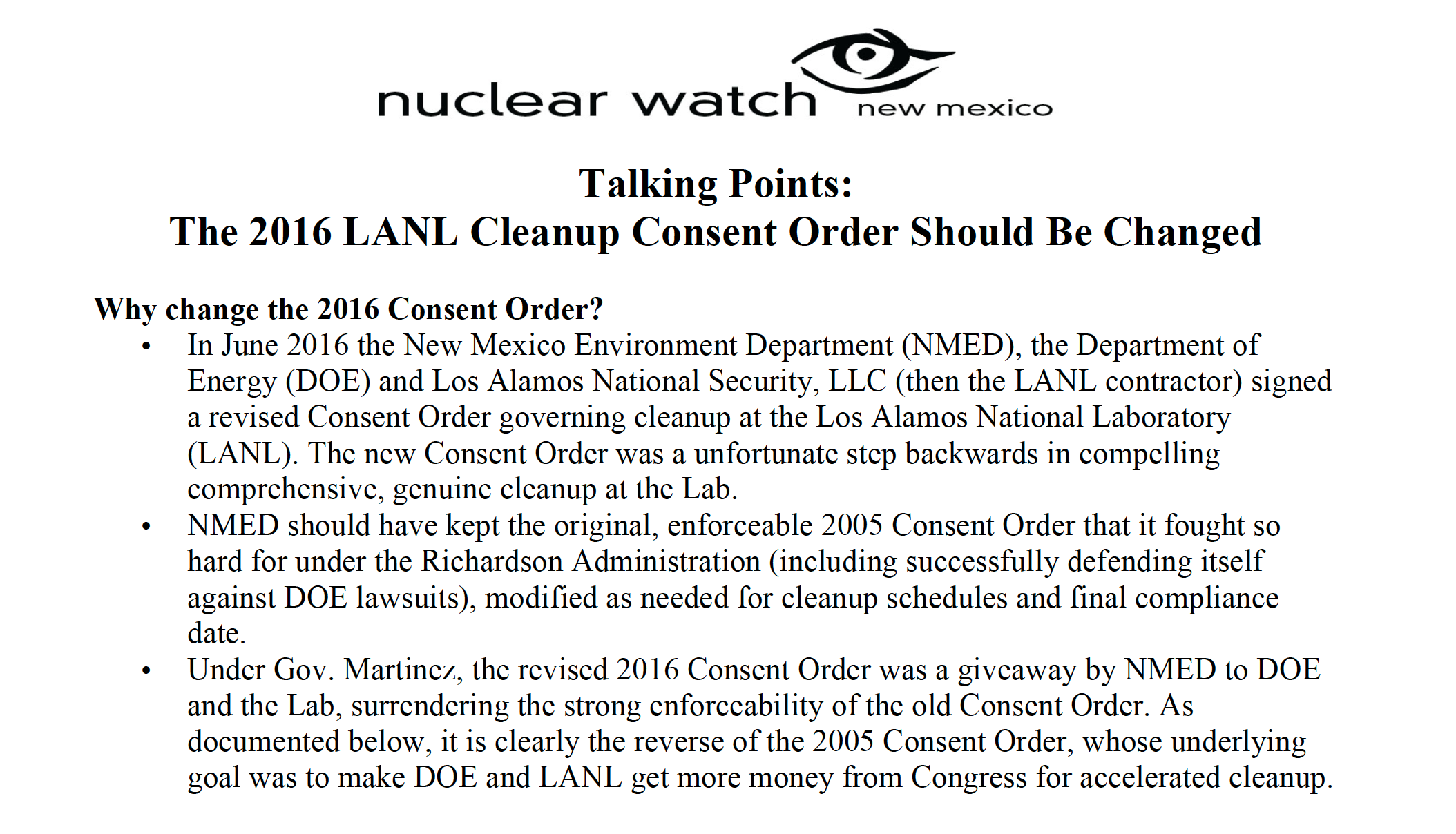Full Recording: Second Scoping Hearing for NNSA’s Programmatic Environmental Impact Statement on Plutonium Pit Production
Operation Crossroads: “The World’s First Nuclear Disaster”
“With Trump back in office, the recurring question of the need for nuclear weapons testing has resurfaced in the national security debate. Project 2025’s directive that the US return to ‘immediate test readiness’ raises further alarm, given the primacy of that document in Trump’s circle. The general uncertainty around current U.S. nuclear posture gives added weight to the historical importance of the atmospheric and underwater nuclear weapons tests conducted on the Bikini Atoll, recounted here by one of the leading advocates for public safety in the nuclear age. —Ed.”
By Robert Alvarez | Washington Spectator, National Security | May 29, 2025, washingtonspectator.com
Beginning in the late 1970’s, I was working for the Environmental Policy Institute around the time when atomic veterans started to descend on the nation’s capital. I would arrange meetings with Congressional offices, and the offices of both the Defense Nuclear Agency and Veterans Affairs, to enable the veterans to share their experiences and seek justice for being sent in harm’s way. About 250,000 soldiers, sailors, Marines, Coast Guard men, and airmen took part in atmospheric nuclear weapons tests from 1945 to 1963.
John Smitherman and Anthony Guarisco were 17- and 18-year-old sailors, respectively, in July of 1946, when they took part in “Operation Crossroads”—the first two nuclear weapons tests following World War II. These tests were conducted on the Bikini Atoll of the Marshall Islands and codenamed “Able” and “Baker.”
As a result of this extraordinary indifference to lethal danger, some 200 U.S. Navy ships were contaminated, and ships carrying radioactive fallout subsequently sailed to home ports in California. These ports are still being cleaned up today, nearly 80 years later. Glenn Seaborg, the chairman of the Atomic Energy Commission from 1961 to 1971, described the Baker test as “the world’s first nuclear disaster.”
Anthony and John were part of the U.S. Navy’s Pacific fleet involving 40,000 service men and 2,000 civilians. They along with others swam in the heavily contaminated Bikini Lagoon. When I met them in 1980, John was suffering from lymphatic cancer and Anthony from a severe form of spinal arthritis.
In March 1983, Anthony and his wife Mary showed up at my cluttered office and ceremoniously handed me a large stack of documents. They had just visited the UCLA library in Los Angeles and found boxes of forgotten, declassified documents belonging to Dr. Stafford Warren, the chief safety officer during both the Manhattan Project and the 1946 Crossroads tests.
Full Recording: First Scoping Hearing for NNSA’s Programmatic Environmental Impact Statement on Plutonium Pit Production
NEW Report on Plutonium Pit Production from the Union of Concerned Scientists
Today, UCS is releasing a comprehensive report on plutonium pit production. It includes a technical assessment of plutonium aging, a critical look at the weapons programs that new pits are slated for, and suggestions for alternatives, including pit re-use.
The final chapter of the study is on the human and environmental impacts of pit production and is intended as a tool for local advocacy groups to deepen their own work around issues such as the programmatic environmental impact survey that has just kicked off.
Links to the report:
https://www.ucs.org/resources/plutonium-pit-production
Spanish language executive summary:
https://es.ucs.org/recursos/la-produccion-de-nucleos-de-plutonio
Plutonium Pit PEIS Scoping Hearing Presentation: Slides and Recording
Get Prepared: A coalition of advocacy groups, including Union of Concerned Scientists, Tri-Valley CAREs, and NukeWatch New Mexico recently held a training to help participants prepare effective comments.
Watch the recording here
Password: gP=&0LYZ
Nuclear Weapons Issues & The Accelerating Arms Race: May 2025
Nuclear Weapons Budget:
• Republicans are pushing for $1 trillion per year for military spending. The fiscal 2026 budget request calls for $892.6 billion in discretionary defense funding — same as FY 2025 (and a cut given inflation). But they are also seeking $119.3 billion through budget “reconciliation.”
• Congressional Budget Office “Projected Costs of U.S. Nuclear Forces, 2025 to 2034,” April 2025:
“Costs of Current Plans: If carried out, DoD’s and DOE’s plans to operate, sustain, and modernize current nuclear forces and purchase new forces would cost a total of $946 billion over the 2025–2034 period, or an average of about $95 billion a year, CBO estimates… CBO’s current estimate of costs for the 2025–2034 period is 25 percent (or $190 billion) larger than its 2023 estimate of $756 billion, which covered the 2023–2032 period.” https://www.cbo.gov/system/files/2025-04/61224-NuclearForces.pdf
Separately it was reported that the twelve new Columbia class submarines will cost $12 billion each, three times more than their projected cost in 2010 and is years behind schedule.
Nuclear Weapons Update:
Nuclear weapons and delivery systems would get an added $12.9 billion in the new reconciliation proposal. This includes $2 billion for sea-launched nuclear cruise missiles and $400 million for their warhead.
Accelerating Arms Race
• The current conflict between India and Pakistan is dangerous.
• 4-4-25 ExchangeMonitor: https://www.exchangemonitor.com/wrap-up-russias-modern-arsenal-and-nukes-in-ukraine-deputy-secretary-of-energy-hearing-rubio-japan-and-rok-in-brussels-more/
“Russia’s top commander in Ukraine Gen. Sergei Surovikin discussed using nuclear weapons to prevent Ukraine from advancing into Crimea in the fall of 2022, the New York Times said March 29. The Times cited U.S. intelligence reports…”
Lawsuit Compels Nationwide Public Review of Plutonium Bomb Core Production
AIKEN, S.C. — Today the National Nuclear Security Administration (NNSA), the semi-autonomous nuclear weapons agency within the Department of Energy, published a formal Notice of Intent in the Federal Register to complete a nationwide “programmatic environmental impact statement” on the expanded production of plutonium “pit” bomb cores. Pits are the essential radioactive triggers of modern nuclear weapons. The NNSA is aggressively seeking their expanded production for new-design nuclear weapons for the new nuclear arms race.
The South Carolina Environmental Law Project (SCELP) successfully represented the Gullah/Geechee Sea Island Coalition and Nuclear Watch New Mexico, Savannah River Site Watch and Tri-Valley Communities Against a Radioactive Environment in a legal challenge to NNSA’s attempt to improperly jump start dual site pit production. On September 30, 2024, United States District Court Judge Mary Geiger Lewis ruled that the NNSA had violated the National Environmental Policy Act (NEPA) by failing to properly consider alternatives before proceeding with its plan to produce at least 30 pits per year at the Los Alamos National Laboratory (LANL) in New Mexico and at least 50 pits per year at the Savannah River Site (SRS) in South Carolina.
NNSA issues plans to assess pits environmental impact
“This programmatic environmental impact statement that we fought long and hard for empowers citizens to tell policy makers what they think about decisions being made in their name,” Jay Coghlan, from environmentalist group Nuclear Watch New Mexico, said Thursday in a press release by the plaintiffs of the case. “Let them know what you think about the $2 trillion ‘modernization’ program to keep nuclear weapons forever while domestic programs are gutted to pay for tax cuts for the rich.”
By ExchangeMonitor | May 9, 2025 exchangemonitor.com
On the heels of a federal judge’s ruling last fall, the Department of Energy’s National Nuclear Security Administration formally announced plans Friday for a detailed review of environmental impacts of planned plutonium pit production.
DOE’s semi-autonomous National Nuclear Security Administration (NNSA) announced in the Federal Register it is kicking off a programmatic environmental impact statement EIS to ensure that large-scale pit production will comply with the National Environmental Policy Act (NEPA).
According to the Federal Register notice, NNSA will hold public meetings and public hearings as part of the process.
Two online public scoping meetings are now scheduled for May 27 and May 28. The May 27 session would commence at 5 p.m. Eastern Time while the May 28 one is scheduled to start at 7 p.m. Eastern. Both can be accessed online or by phone. Details can be found in the Federal Register notice.
A federal district judge ruled last September that DOE and NNSA did not adequately analyze the environmental effects of producing the radioactive cores that trigger nuclear weapons in two different states, but declined to put the pit program, including construction of the Savannah River Plutonium Processing Facility at Aiken, S.C.’s Savannah River Site on hold as a result. In January, the federal government and the plaintiffs, consisting of environmentalists, settled the lawsuit and agreed to leave Los Alamos National Laboratory as the sole pit factory until NNSA completes a nationwide, NEPA-compliant programmatic EIS.Continue reading
US nuclear firm ‘utterly crucial’ to national security expands East Tennessee operations
“Which company produces uranium fuel for U.S. Navy nuclear reactors and manages the only plant where the government disassembles atomic warheads? What about the company helping NASA to develop a nuclear rocket, all while building small modular reactors and developing a pilot plant to restart uranium enrichment for the military?”
By Daniel Dassow, Knoxville News Sentinel | May 5, 2025 newsbreak.com
It’s all the same answer: BWX Technologies , the $2.7 billion juggernaut better known as BWXT has embedded itself in every kind of nuclear project imaginable with a strong and growing presence in East Tennessee, where 1,100 employees at its Nuclear Fuel Services plant in Erwin “downblend” bomb-grade uranium. The facility also creates fuel for the nuclear reactors aboard U.S. Navy submarines and aircraft carriers.
The region is even more important to BWXT after it bought a specialized facility in Jonesborough and 97 acres in Oak Ridge for a centrifuge enrichment project the company says will create hundreds of jobs through millions of dollars in investments.
“We have availed ourselves as a key player in just about every interesting nuclear opportunity that you can think of,” BWXT President and CEO Rex Geveden told Knox News. “We’re all over it.”
BWXT is part of the team led by the Tennessee Valley Authority to build the first small modular nuclear reactors in the U.S. at the federal utility’s Clinch River Nuclear Site in Oak Ridge .
It will manufacture the reactor pressure vessel, the largest component of the 300-megawatt reactor designed by GE Hitachi Nuclear Energy , for small modular reactors in the U.S. and Canada.
Curb the Skyrocketing Cost of U.S. Nuclear Modernization
“Since Russia and the United States agreed 15 years ago to modest nuclear reductions under the New Strategic Arms Reduction Treaty (New START), they also have embarked on extraordinarily expensive campaigns to replace and modernize every component of their respective nuclear arsenals to maintain force levels and provide the option to build up.”
By Daryl G. Kimball, Arms Control Today | May 1, 2025 newsbreak.com
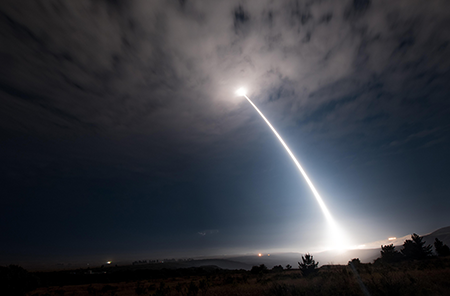
At the same time, their leaders have failed to resolve disputes about existing treaties or launch new negotiations to limit or further cut their deadly arsenals below the New START ceiling of 1,550 deployed nuclear warheads and 700 strategic missiles and bombers each.
In 2018, shortly after he withdrew the United States from the Intermediate-Range Nuclear Forces Treaty, U.S. President Donald Trump foolishly bragged about the nuclear stockpile that “until people come to their senses, we will build it up. It’s a threat to whoever you want, and it includes China, and it includes Russia, and it includes anybody else that wants to play that game.”
China has responded to U.S. nuclear and conventional military plans by pursuing a buildup of its historically “minimal” nuclear force to ensure that it retains an assured “second strike” capability. Russia has continued to develop new types of intermediate range missiles, as well as some new and exotic strategic systems designed to bypass U.S. missile defense capabilities.
Successive presidential administrations and congresses have failed to seriously consider alternatives that would have reduced costs and still maintained a devastating nuclear force.
Now, the cost of the U.S. nuclear modernization program is skyrocketing even further, siphoning resources from other more pressing human needs and national security priorities.
In April, the Congressional Budget Office issued its latest 10-year cost projection of the departments of Defense and Energy plans to operate, sustain, and modernize existing U.S. nuclear forces and purchase new forces: a total of $946 billion in the 2025-2034 period, or about $95 billion per year.
This new estimate is 25 percent, or $190 billion, greater than the last CBO estimate of $756 billion, which covered the 2023-2032 period. Incredibly, the $946 billion estimate does not include all of the likely cost growth of the new Sentinel intercontinental ballistic missile program, which the Pentagon acknowledged in July 2024 would cost 81 percent, or $63 billion, more than the program’s baseline estimate of $78 billion, generated in 2020.
Find Out the Facts & Sign the Petition: Why NMED Should Deny LANL’s Request for Tritium Releases
Why NMED Should Deny LANL’s Request for Tritium Releases
The Los Alamos National Laboratory plans to begin large releases of radioactive tritium gas any time after June 2, 2025. The only roadblock to the Lab’s plans is that it needs a “Temporary Authorization” from the New Mexico Environment Department to do so.
Reasons why NMED should deny LANL’s request are:
- The state Environment Department has a duty to protect the New Mexican As it states, “Our mission is to protect and restore the environment and to foster a healthy and prosperous New Mexico for present and future generations.” 1
- Why the rush? LANL explicitly admits there is no urgency. According to the Lab’s publicly-released “Questions and Answers” in response to “What is the urgency for this project?”
“There is no urgency for this project beyond the broader mission goals to reduce onsite waste liabilities.” 2
-
- In addition, the National Nuclear Security Administration (NNSA) admits that the end time frame for action is 2028, not 2025.3 Therefore, there is time for deliberate consideration.
- Contrary to NMED’s Resource Conservation and Recovery Act permit for LANL, the Lab has not fulfilled its duty to inform the public via NMED of possible alternatives to its planned tritium releases.4 According to Tewa Women United, “LANL has told EPA there are 53 alternatives; that list of alternatives, initially requested in 2022, has not yet been Tewa Women United has repeatedly asked LANL to provide the public with that list.” 5
University of New Mexico to host exhibit on nuclear history, technology, weapons
ALBUQUERQUE, N.M. (KRQE) — A provocative international exhibit will open soon at the University of New Mexico. “the bomb” is an immersive, multi-media installation exploring the history, technology, and threat of nuclear weapons.
By Nicole Sanders, KRQE | April 22, 2025 krqe.com
The installation includes an hour-long film projected on 45 screens conveying the hidden chaos and danger of the nuclear age. The experience is coming to UNM from April 30 to May 30. The full schedule at Zimmerman Library is available below:
- Wednesday, April 30
- Friday, May 2, 2025
- Friday, May 9, 2025
- Friday, May 16, 2025
- Friday, May 23, 2025
- Friday, May 30, 2025
Formal Comments on the Draft Site-Wide Environmental Impact Statement for Continued Operation of the Los Alamos National Laboratory
The National Environmental Policy Act requires the Los Alamos National Laboratory to periodically prepare a new “Site-Wide Environmental Impact Statement (SWEIS) for Continued Operations.”
Please use NukeWatch NM’s recent extensive comments on the Lab’s new draft SWEIS as a resource and citizens’ guide to Lab issues.
Did you know, for example, that:
• LANL’s nuclear weapons production budget has doubled over the last decade?
• The Lab’s so-called cleanup plan is to “cap and cover” some 200,000 cubic yards of radioactive and toxic waste, leaving them permanently buried as a perpetual threat to groundwater?
• There is a planned intentional release of up to 30,000 curies of radioactive tritium gas, all without a public hearing?
Use our lengthy formal comments as a starting point, toolkit or resource for dissecting ongoing and future issues at LANL!
We encourage you to use our comments to ask for follow-up info, either from us here at NukeWatch or from the Lab, and to demand better accountability and transparency! Use as background or briefing material for local and congressional advocacy.
For example:
- Cite or excerpt our comments in future public processes under the National Environmental Policy Act. For example, we are expecting that a nationwide programmatic environmental impact statement for plutonium “pit” bomb core production will be announced soon, the result of a lawsuit in which NukeWatch led.
- Share with those organizing around stopping expanded plutonium pit production and advocating for genuine radioactive and toxic wastes cleanup.
- Learn about LANL’s proposed electrical transmission line across the environmentally and culturally sensitive Caja del Rio and alternatives that were not considered.
- The National Environmental Policy Act itself is under assault by the Trump Administration. We expect environmental justice and climate change issues to be stripped from LANL’s final Site-Wide Environmental Impact Statement. This needs to be resisted!
NukeWatch NM argued that the draft SWEIS should be withdrawn and a new one issued because:
• The NNSA has rigged the draft LANL Site-Wide EIS with three self-serving scenarios:
– Expanded nuclear weapons programs (contradictorily called the “No Action Alternative”).
– Yet more expanded nuclear weapons programs (“Modernized Operations Alternative”).
– Yet far more expanded nuclear weapons programs (“Expanded Operations Alternative”).
• A Reduced Operations Alternative must be included.
• The SWEIS’ fundamental justification for expanded nuclear weapons programs is “deterrence.” But “deterrence” has always included nuclear warfighting capabilities that could end human civilization overnight.
• The SWEIS purports to align with U.S. obligations under the 1970 NonProliferation Treaty. That is demonstrably false.
• Future plutonium pit production is NOT to maintain the safety and reliability of the existing nuclear weapons stockpile. Instead, it is for new-design nuclear weapons that could lower confidence in stockpile reliability and/or prompt a return to testing.
• The SWEIS’ No-Action Alternative violates the National Environmental Policy Act (NEPA).
• The legally required programmatic environmental impact statement on pit production should be completed first, followed by the LANL SWEIS.
• Plutonium pit reuse should be analyzed as a credible alternative to pit production.
• A recent proposal for a data center at LANL is not in the SWEIS. It raises huge issues of future water and electrical use, the appropriateness of commercial interests at a federal lab, and the possible fusion of artificial intelligence and nuclear weapons command and control.
• Recent Executive Orders could strip the final SWEIS of environmental justice and climate change analyses. This must have clarification.
• Planned tritium releases should be fully analyzed.
• The Electrical Power Capacity Upgrade should be analyzed will all credible alternatives.
• The proposed BioSafety Level-3 facility must have its own standalone EIS.
• All Defense Nuclear Facilities Safety Board concerns should be addressed and resolved.
• Genuine comprehensive cleanup should be a preferred alternative.
• A new SWEIS should follow a new overdue Probabilistic Seismic Hazard Analysis.
Nuclear Weapons Issues & The Accelerating Arms Race: April 2025
Nuclear weapons
Air Force Weighs Keeping 1970s-Era Missiles Until 2050
The US Air Force is considering contingency plans that would extend the life of 1970s-era intercontinental ballistic missiles by 11 more years to 2050 if delays continue to plague the new Sentinel models intended to replace them. The current plan is to remove all 400 Minuteman III ICBMs made by Boeing Co. from silos by 2039… The Sentinel was projected last year to be deployed starting in May 2029. The first test flight was once projected for December 2023, but fiscal 2025 budget documents indicated a slip to February 2026.
The estimated cost of the new Sentinel intercontinental ballistic missiles (ICBM), originally at ~$110 billion, is now north of $180 billion. And this is before recognition of the immensity of supplying new command and control communications and recent consideration that its hardened silos may have to be replaced. IMHO it’s a propitious time to argue again for eliminating the land-based ICBM leg of the Triad. After all, one of its stated purposes is to act as a “nuclear sponge” for incoming Russian warheads. The odds of that are not zero and may increase if ICBMs are uploaded with multiple warheads after the New Strategic Arms Reduction Treaty expires in February 2026. More temptation for a preemptive first strike.
Calls to restart nuclear weapons tests stir dismay and debate among scientists
By Emily Conover, Science News | March 27, 2025 sciencenews.org
When the countdown hit zero on September 23, 1992, the desert surface puffed up into the air, as if a giant balloon had inflated it from below.
It wasn’t a balloon. Scientists had exploded a nuclear device hundreds of meters below the Nevada desert, equivalent to thousands of tons of TNT. The ensuing fireball reached pressures and temperatures well beyond those in Earth’s core. Within milliseconds of the detonation, shock waves rammed outward. The rock melted, vaporized and fractured, leaving behind a cavity oozing with liquid radioactive rock that puddled on the cavity’s floor.
As the temperature and pressure abated, rocks collapsed into the cavity. The desert surface slumped, forming a subsidence crater about 3 meters deep and wider than the length of a football field. Unknown to the scientists working on this test, named Divider, it would be the end of the line. Soon after, the United States halted nuclear testing.
Beginning with the first explosive test, known as Trinity, in 1945, more than 2,000 atomic blasts have rattled the globe. Today, that nuclear din has been largely silenced, thanks to the norms set by the Comprehensive Nuclear-Test-Ban Treaty, or CTBT, negotiated in the mid-1990s.
Only one nation — North Korea — has conducted a nuclear test this century. But researchers and policy makers are increasingly grappling with the possibility that the fragile quiet will soon be shattered.
Some in the United States have called for resuming testing, including a former national security adviser to President Donald Trump. Officials in the previous Trump administration considered testing, according to a 2020 Washington Post article. And there may be temptation in coming years. The United States is in the midst of a sweeping, decades-long overhaul of its aging nuclear arsenal…
Nuclear Nightmare: Meet America’s New B61-12 Gravity Bomb
What makes the B61-12 particularly impressive is the bomb’s ability to adjust its destructive yield depending on the operational conditions and demands.
By Stavros Atlamazoglou, National Interest | March 26, 2025 nationalinterest.org
Over the past months, the U.S. Air Force added another potent weapon to its arsenal: a new nuclear bomb, having recently completed production at Sandia National Laboratories in Albuquerque, New Mexico.
The B61-12 nuclear gravity bomb achieved full system production recently and is now fully operational. The nuclear bomb is one of the most versatile munitions of its type in the world, and a useful addition to the U.S. military’s nuclear deterrent capabilities.
The B61-12’s Unique Variable Yield Design
Sandia, one of the three main research and development laboratories for nuclear munitions, completed the production of the B61-12 nuclear gravity bomb. The nuclear munition is now fully operational.
What makes the B61-12 particularly impressive is the bomb’s ability to adjust its destructive yield depending on the operational conditions and demands. Put simply, the B61-12 is four bombs in one. The nuclear munition can be adjusted to four different yields—0.3, 1.5, 10, or 50 kilotons. The difference in yields means that the B61-12 has tactical, operational, and potentially even strategic utility.
Eight decades of nuclear threats are too much
Santa Fe New Mexican: My View John C. Wester
By John Wester, The Santa Fe New Mexican | March 15, 2025 santafenewmexican.com
I am John C. Wester, Archbishop of Santa Fe. I’m speaking on behalf of my archdiocese, and the archbishop of Seattle, the bishop of Hiroshima, and the archbishop of Nagasaki. We take guidance from our Holy Father, Pope Francis, who has declared the very possession of nuclear weapons to be immoral. We pray for his health.
Two years ago, in Nagasaki, on the 78th anniversary of its atomic bombing, we Catholic leaders formally created the Partnership for a World without Nuclear Weapons. Our four dioceses include the birthplace of nuclear weapons, the most deployed weapons in the United States, and the only two cities that to date have suffered atomic bombings. We lend our voices in staunch support of the Treaty on the Prohibition of Nuclear Weapons, at this Third Meeting of State Parties.
In July 2017, the Vatican was the first nation-state to sign and ratify the treaty. We note that the nuclear weapons powers have never honored their long-held obligations, under the 1970 Non-Proliferation Treaty, to enter into serious negotiations leading to global nuclear disarmament.
In contrast, the entry into force of the ban treaty was a great step toward the light of peace. The nuclear armed states have a moral obligation to hear the voices of the majority of the world, and to listen to those who are threatened by annihilation, at the whim of any one of their nine leaders.
The New York Times: DOGE Cuts Reach Key Nuclear Scientists, Bomb Engineers and Safety Experts
“Firings and buyouts hit the top-secret National Nuclear Security Administration amid a major effort to upgrade America’s nuclear arsenal. Critics say it shows the consequences of heedlessly cutting the federal work force.”
“The department has said that most of the fired employees handled administrative and clerical tasks that were not critical to the agency’s operation. But an analysis of the internal documents by The Times, coupled with interviews with 18 current and former agency officials, shows that is not true for the bulk of people who took the buyout,”
By Sharon LaFraniere, Minho Kim and Julie Tate, The New York Times | March 17, 2025 nytimes.com
…The Times reports that many had top-secret security clearance, giving them access to information on how nuclear weapons are made.
North Korea vows to ‘strengthen’ nuclear capabilities, rejecting G7 call for denuclearization
“The G7 called on Friday for North Korea to “abandon” its nuclear program.”
By Kevin Shalvey, ABC News | March 17, 2025 abcnews.go.com
LONDON — North Korea on Monday vowed to “steadily update and strengthen” its nuclear capabilities, a firm rejection of the G7’s call for Pyongyang to “abandon” its nuclear ambitions.
The country’s Foreign Ministry said that its “nuclear armed forces will exist forever as a powerful means of justice which defends the sovereignty of the state, territorial integrity and fundamental interests,” according to the Korean Central News Agency, a state-run media outlet.
How nuclear deterrence in Europe may change
“What does nuclear deterrence look like in Europe now that NATO is unsure whether the U.S. will be a committed partner? NPR speaks with Paul Cormarie, analyst with the Rand Corporation.”
By A Martínez, NPR | March 17, 2025 abcnews.go.com
Russia’s president, Vladimir Putin, says he supports a 30-day ceasefire with Ukraine in theory. But he adds that Ukraine would need to accept further conditions before a deal could be finalized. Now, in the interim, European leaders are discussing ways to discourage future Russian aggression. French President Emmanuel Macron has proposed using France’s nuclear capabilities as a deterrent to Russian threats. But what does nuclear deterrence look like in Europe if NATO is unsure if the U.S. will be a committed partner?
Hanford nuclear site subcontractor, owner to pay $1.1M for COVID loan fraud
“The money was intended to retain and maintain payroll for Hanford site workers assigned to the nuclear reservation in Eastern Washington and also a few Department of Veterans Affairs workers during the COVID-19 pandemic.”
“Within 48 hours of BNL receiving the Paycheck Protection Program loan at least $453,000 had been spent to pay off Stevenson’s personal and family debts, according to an indictment.
That included $100,000 transferred to Stevenson’s father and $48,600 to a family trust, according to court documents.
Much of the rest of the money was used to pay off credit card debt, according to the indictment.
The federal government later forgave the loan, which cleared it from having to be repaid.
BNL and Stevenson later applied for and received another Paycheck Protection Program loan of nearly $820,000.”
By Annette Cary, Tri-City Herald (Kennewick, Wash.) (TNS), The Columbian | March 12, 2025 columbian.com
Mar. 11—A former Hanford nuclear site subcontractor and its owner will pay a total settlement of just over $1.1 million to resolve accusations they defrauded the federal government through a COVID pandemic loan program.
On Wednesday, U.S. Judge Stanley Bastian in Yakima sentenced BNL Technical Services, owned by Wilson Pershing Stevenson III, to pay nearly $494,000 restitution to the federal government, as proposed in a settlement agreement.
That is in addition to $611,000 Stevenson, of Nashville, Tenn., already agreed to pay in a civil settlement to resolve his liability in the case.
Nuclear Watch New Mexico and Santa Fe Archbishop John C. Wester Attend the Third Meeting of States Parties to the Treaty on the Prohibition of Nuclear Weapons
We had the honor of joining the Archbishop of Santa Fe, John Wester, in attending the third Meeting of States Parties to the Treaty on the Prohibition of Nuclear Weapons last week, March 3-7 in New York City. The archbishop gave mass to several different groups (see photos below) and spoke at the UN headquarters as part of Civil Society.
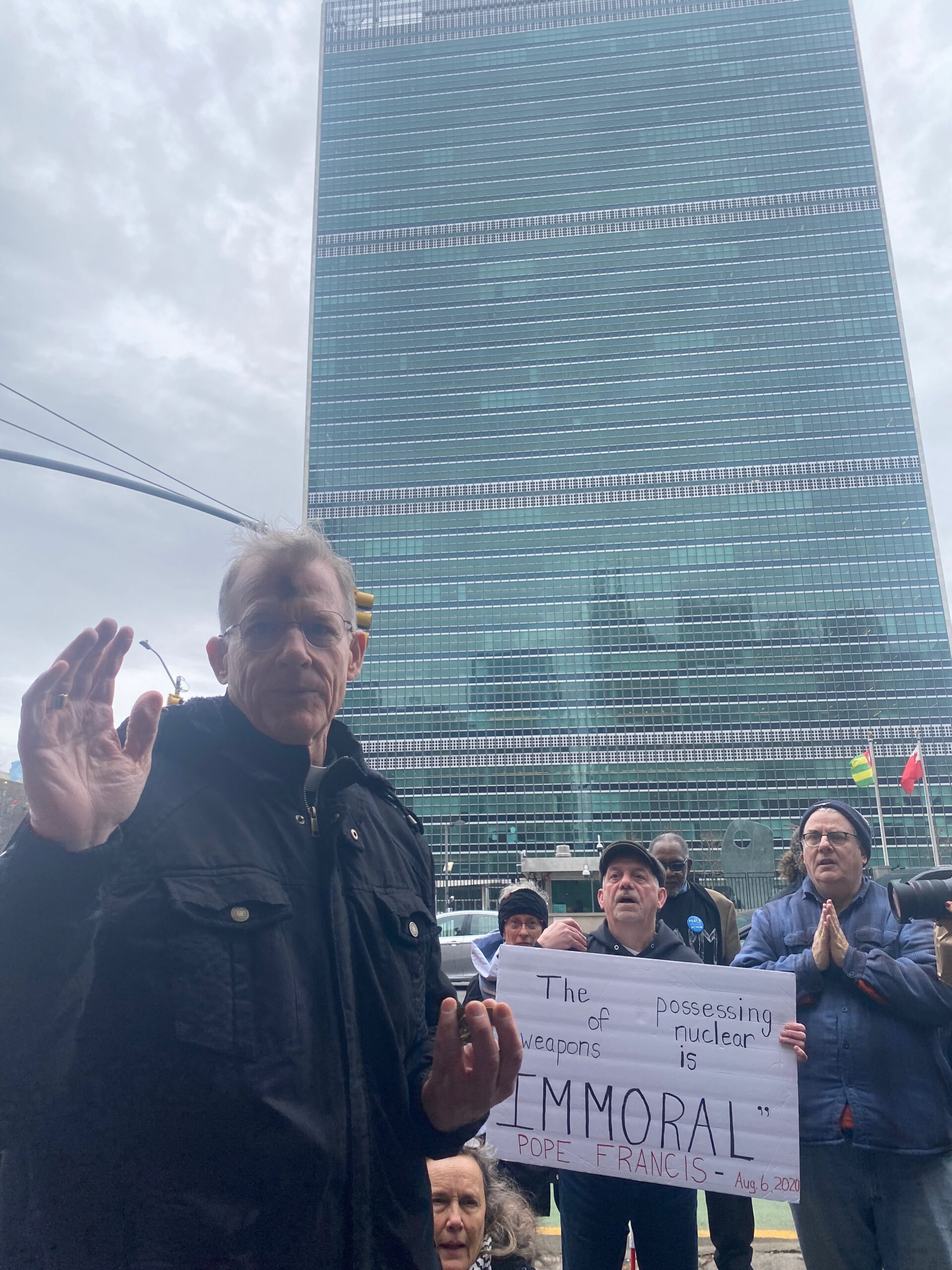
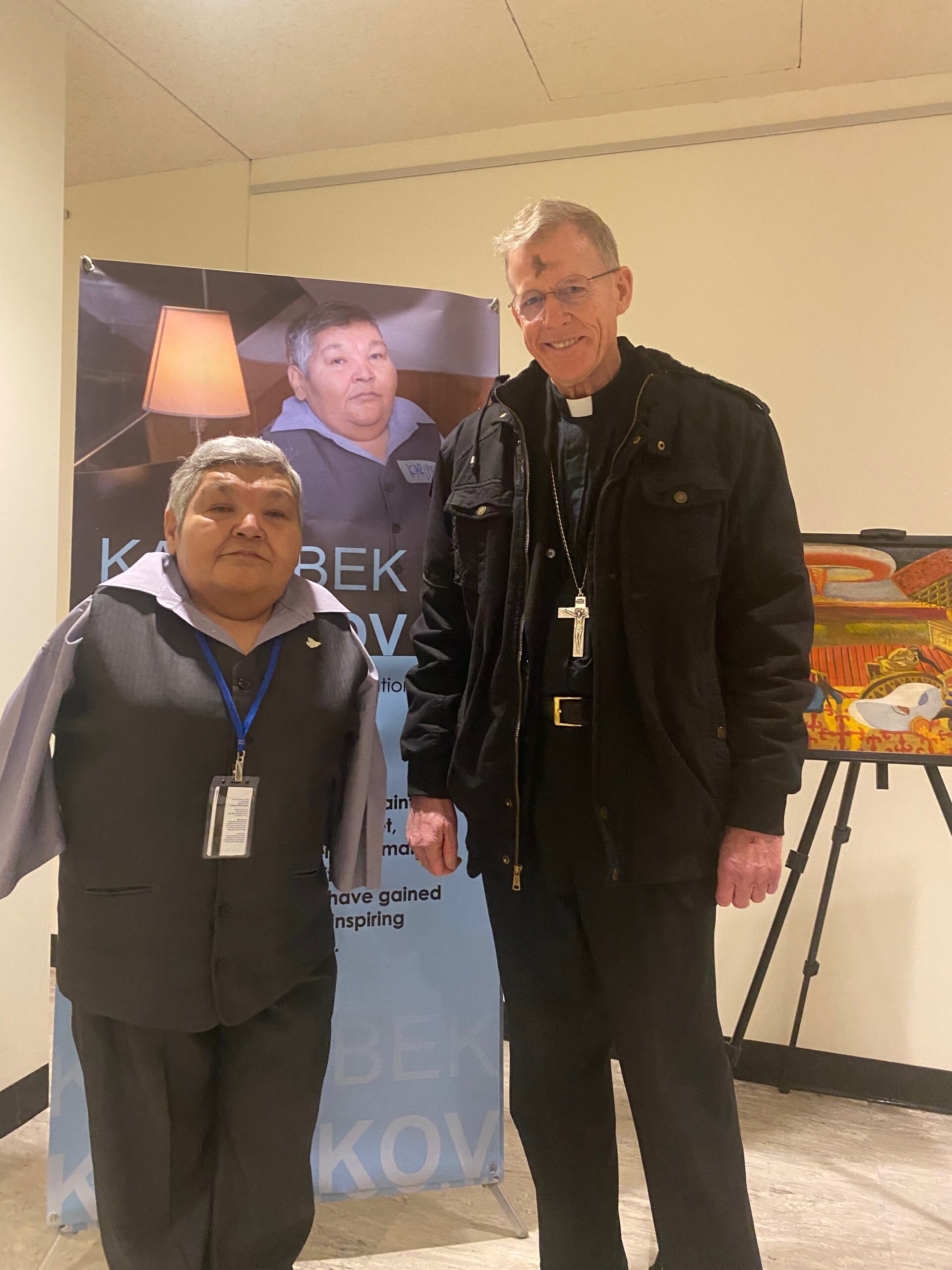
In New York City this week? Join Pax Christi members and friends at Mass with Archbishop John Wester (Santa Fe NM) on Tuesday, March 4, 6 pm, at the Church of Our Saviour, 59 Park Avenue at 38th Street. Use this link to RSVP. #TPNW #3MSP #nucleardisarmamentwww.dorothydayguild.org/WesterMass25
— Pax Christi USA (@paxchristiusa.bsky.social) 2025-03-03T16:35:50.942Z
Germany skips UN conference on banning nuclear weapons in New York
“Germany has decided not to take part in a UN conference in New York to review a landmark treaty on nuclear weapons prohibition.”
By dpa International | March 4, 2025 dpa-international.com
“The Treaty on the Prohibition of Nuclear Weapons dates back to a time before the Russian war of aggression against Ukraine,” the Foreign Office told dpa in Berlin on Tuesday. “The intention and ambition of the treaty no longer reflect the current reality in security policy.”
The treaty was signed in 2017 and came into force in 2021. There are currently 94 signatories and 73 states parties, according to the International Campaign to Abolish Nuclear Weapons (ICAN).
Germany does not possess nuclear weapons but is allied with three nuclear powers in NATO: the United States, France and the United Kingdom.
Berlin is not a signatory to the prohibition treaty, but it participated in previous conferences as observers.
Brief Analysis of Today’s U.S. Supreme Court Oral Arguments on the Illegality of Licensing Radwaste Dumps in TX and NM
Today the United States Supreme Court heard arguments in the case of the Nuclear Regulatory Commission vs. Texas. At issue is whether the NRC exceeded its authority when it approved licenses for proposed “consolidated interim storage facilities” for high-level radioactive waste, and this includes highly irradiated “spent” fuel from nuclear power plants.
Two consolidated interim storage facilities are planned for western Texas and southeastern New Mexico. The Nuclear Waste Policy Act of 1982, as Amended specifically prohibits private “interim” storage of federal spent nuclear fuel, and disallows the Department of Energy from taking title to the waste unless a permanent geologic repository is licensed, built and opened. The law intended to prevent private “interim” storage of federal radioactive waste because interim storage is much less robust than permanent storage, and would double the risk of accident or attack during transport, since consolidated “interim” storage means the waste has to be moved twice, once to the CISF and again to a permanent repository.
Broken arrows: The hidden secret behind America’s missing nuclear weapons
“Dedicated Navy divers, demolition teams, and high-powered sonar spent weeks searching the ocean floor and came up empty.”
By Kaif Shaikh, Interesting Engineering | March 3, 2025 interestingengineering.com
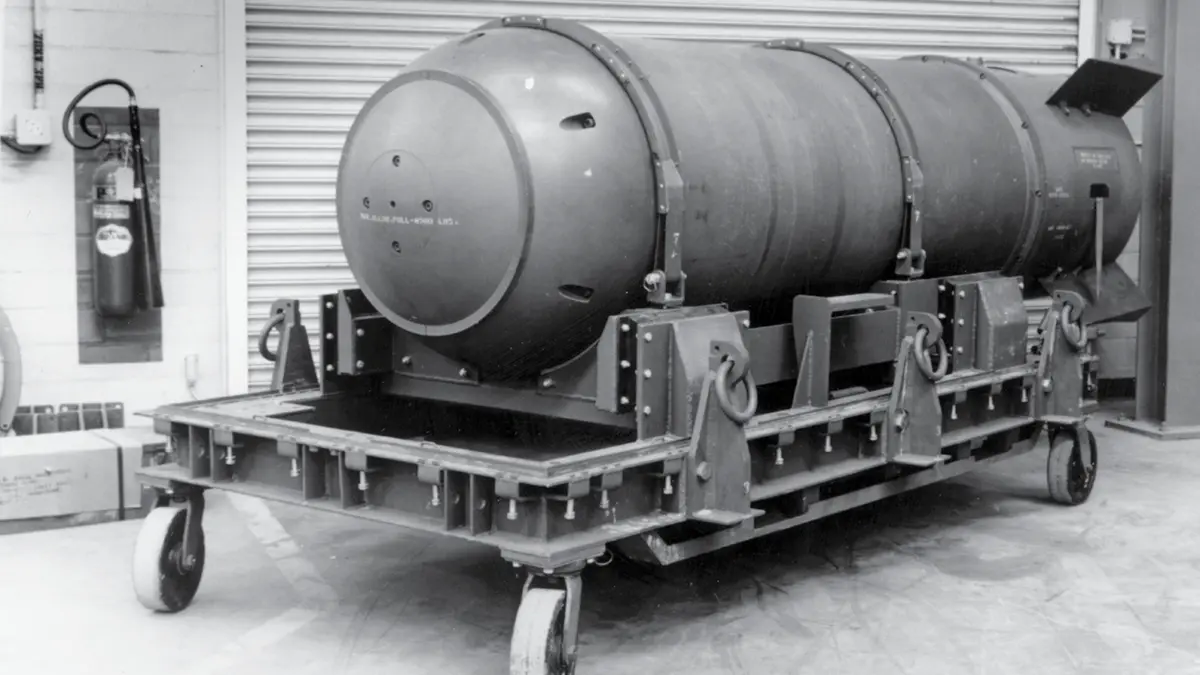
Throughout history, the idea of misplacing a nuclear weapon may sound like a plot twist in an espionage novel. The United States has experienced more than a handful of such incidents. Known as “Broken Arrows,” these events typically refer to any accidents involving nuclear weapons that do not pose an immediate risk of triggering a nuclear war.
For decades, details remained hidden behind top-secret clearances. However, unclassified records reveal that the U.S. military has had a surprising number of mishaps, with some bombs still unaccounted for to this day.
What are broken arrows?
The Department of Defense defines a “Broken Arrow” as any incident involving a U.S. nuclear weapon or warhead that results in accidental launching, firing, detonating, theft, or loss of the weapon. From 1950 to 1980, official sources cite 32 Broken Arrow incidents, but there may have been more, given the secrecy surrounding nuclear matters.
Christie Brinkley: Don’t let the US resume nuclear weapon tests that ended decades ago
“The United States and other nuclear powers are now moving closer to resuming nuclear weapons tests, decades after testing ended. This highly disturbing trend must be halted.”
By Christie Brinkley Special to The Kansas City Star Miami Herald | March 3, 2025 miamiherald.com
Since the atomic age, 2,056 nuclear weapons have been detonated, 528 of them above the ground. The United States and Soviet Union accounted for about 85% of these tests. The explosive power of atmospheric tests equaled 29,000 Hiroshima bombs. Airborne radioactive fallout circled the globe, re-entered the environment through precipitation, and entered human bodies through food and water.
Cold War bomb testing was part of a massive increase in the number of nuclear weapons, which peaked at more than 60,000. After nuclear war was barely avoided during the Cuban missile crisis, public pressure convinced leaders to ban all above-ground tests in 1963 — a treaty that has never been violated.
The test ban treaty was a huge achievement for peace, beginning eased tensions between nuclear nations. It also was a landmark for public health. A study by St. Louis residents and scientists found an enormous buildup of radioactive strontium-90 levels in baby teeth — 63 times higher in children born in 1963 compared to those born in 1950.
LISTEN LIVE TO U.S. SUPREME COURT ORAL ARGUMENTS ON THE ILLEGALITY OF LICENSING RADWASTE DUMPS IN TX AND NM
“The case pits the nuclear industry’s push for CISFs against the interests of fossil fuel companies which object to high-level radioactive waste dumped in their drilling/fracking areas, the state governments of Texas and New Mexico, which have passed laws prohibiting importation of nuclear waste to their states, and cities along the transport routes which object to it being shipped through their jurisdictions. Their amicus briefs in the case are posted here.”
For immediate release
MEDIA ALERT for Wednesday, March 5, 2025
WASHINGTON, D.C.,
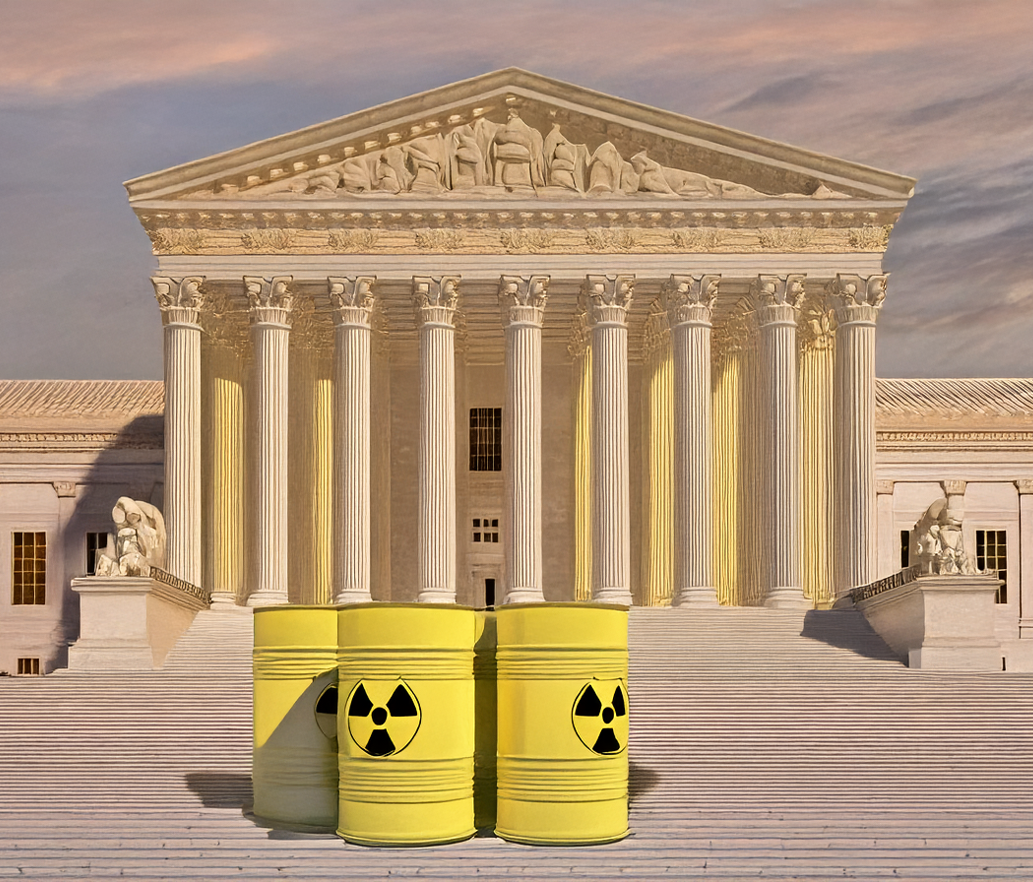 WHAT? Wednesday morning, March 5, the United States Supreme Court will hear oral arguments in Nuclear Regulatory Commission vs. Texas. At issue in the SCOTUS (Supreme Court of the U.S.) proceeding is whether the NRC exceeded its authority when it approved licenses for proposed “consolidated interim storage facilities” for high-level radioactive waste including highly irradiated “spent” fuel from nuclear power plants. Two CISFs are planned for western Texas and southeastern New Mexico. The Nuclear Waste Policy Act of 1982, as Amended specifically prohibits private “interim” storage of federal spent nuclear fuel, and disallows the Department of Energy from taking title to the waste (which would be necessary for DOE to transport it to CISFs), unless and until a permanent geologic repository is licensed, built and opened to receive the waste. The law intended to prevent private “interim” storage of federal radwaste, which is much less robust than permanent storage, and would double the risk of accident or attack during transport, since consolidated “interim” storage necessitates moving the waste twice, once to the CISF and again to a permanent repository. The NRC approved recent CISF license applications despite the law, saying it anticipated Congress would change it in the future. But the federal Fifth Circuit court ruled that the NRC didn’t have that authority. If the Supreme Court strikes that ruling down, it could open the floodgates for thousands of shipments of spent fuel from nuclear power plants across the US, through many states, to CISFs in Texas and New Mexico.
WHAT? Wednesday morning, March 5, the United States Supreme Court will hear oral arguments in Nuclear Regulatory Commission vs. Texas. At issue in the SCOTUS (Supreme Court of the U.S.) proceeding is whether the NRC exceeded its authority when it approved licenses for proposed “consolidated interim storage facilities” for high-level radioactive waste including highly irradiated “spent” fuel from nuclear power plants. Two CISFs are planned for western Texas and southeastern New Mexico. The Nuclear Waste Policy Act of 1982, as Amended specifically prohibits private “interim” storage of federal spent nuclear fuel, and disallows the Department of Energy from taking title to the waste (which would be necessary for DOE to transport it to CISFs), unless and until a permanent geologic repository is licensed, built and opened to receive the waste. The law intended to prevent private “interim” storage of federal radwaste, which is much less robust than permanent storage, and would double the risk of accident or attack during transport, since consolidated “interim” storage necessitates moving the waste twice, once to the CISF and again to a permanent repository. The NRC approved recent CISF license applications despite the law, saying it anticipated Congress would change it in the future. But the federal Fifth Circuit court ruled that the NRC didn’t have that authority. If the Supreme Court strikes that ruling down, it could open the floodgates for thousands of shipments of spent fuel from nuclear power plants across the US, through many states, to CISFs in Texas and New Mexico.
Expanded Plutonium “Pit” Bomb Production is Immoral – Spend Nuclear Weapons “Modernization” Money Ethically ELSEWHERE
Why the nation’s nuclear waste may eventually be headed to northwest Colorado
Nuclear waste is piling up at power plants around the country, and we have no idea where to put it. Many states are aggressively fighting plans for new storage facilities.
But northwest Colorado is quietly opening the door.
By In The NoCo, Scott Franz, Erin O’Toole, Brad Turner | February 22, 2025 kunc.org
KUNC’s investigative reporter Scott Franz recently traveled around rural Colorado talking with people about what nuclear waste storage could do for the local economy – and also interviewing folks who are dead set against that idea.
On this special edition of In The NoCo, we’ve combined all of Scott’s reporting from the past few months into a single episode. You can also see photos and check out more on this investigation.

Arms Control Association – Trump Regains Control Over Nuclear Policy: What’s Next?
It has been barely a month since Inauguration day, but it is apparent that Donald Trump is determined to reshape U.S. foreign policy, radically alter alliance relationships, and upend Washington’s approach toward key adversaries, like Russia, in ways that are not yet clear.
Arms Control Association | February 21, 2025 armscontrol.org
And here at home, Trump’s brash assertion of executive power is putting our nation’s democratic institutions and the rule of domestic law at risk, in part by altering or dismantling key government departments,agencies and functions, all without congressional approval.
All of this makes our mission to provide reliable information and sound policy solutions even more important and difficult.
The Arms Control Association has a clear and focused strategy to reduce the dangers posed by nuclear weapons and other WMD. Many of these priorities are outlined in this ACA-organized January 28 communication to all members of Congress that was endorsed by 16 of our partner organizations and leaders.
Like many others, however, we are still sorting out how to adjust to and contend with the post-Inauguration political dynamics.
But we must and we will, because critical, weapons-related security decisions lie ahead:
- So long as Russia’s assault on Ukraine continues, there is still a heightened risk of nuclear weapons use, and there are narrowing prospects for a deal to maintain limits on the U.S. and Russian nuclear arsenals after New START expires in one year.
- Although Trump has decried exorbitant military expenditures, the authors of Project 2025, the 920-page manifesto crafted by the Heritage Foundation and others, want the United States to spend even more than the current $756 billion ten-year price tag for nuclear modernization in order to increase the size and diversity of the U.S. arsenal. China and Russia are watching and will surely respond to any U.S. nuclear buildup.
- Project 2025 also calls for preparing to resume U.S. nuclear explosive testing for the first time since 1992. Should the United States do so, it would open the door to nuclear testing by other states, unravel the CTBT, and blow apart the global nonproliferation system at a time of increasing nuclear danger.
- Since Trump withdrew from the 2015 Iran nuclear deal, Tehran has expanded its capacity to produce weapons-grade nuclear material and reduced international inspectors’ access. Trump says he wants a nuclear deal; Iran’s president says he wants a nuclear deal. But time is short. Without a deal to scale back tensions and Iran’s nuclear capacity, we could see renewed international sanctions by October, Iranian withdrawal from the NPT, and/or an attempt by Israel to bomb Iran’s nuclear sites.
How exactly the second Trump administration and the new Congress will try to navigate all these nuclear-related challenges ahead is not yet clear — but if Project 2025 becomes the blueprint for U.S. nuclear weapons policy, we are in big trouble.
But, it may also be possible to steer us toward a safer course.
Trump wants to initiate denuclearization talks with Russia and China
On Thursday, President Donald Trump signaled that he wants to engage with Russia and China on denuclearization efforts.
By Erik English, BULLETIN OF ATOMIC SCIENTISTS | February 14, 2025 thebulletin.org
“There’s no reason for us to be building brand new nuclear weapons. We already have so many,” Trump said from the White House.
“You could destroy the world 50 times over, 100 times over. And here we are building new nuclear weapons, and they’re building nuclear weapons, and China’s building nuclear weapons.” The number of nuclear weapons the United States and Russia can have is established by New START, which expires in 2026. Without a new agreement, nuclear states could begin to build up their arsenals for the first time since the Cold War. “Hopefully, there’ll never be a time when we need those weapons,” Trump said. “That’s going to be a very sad day, that’s going to be probably oblivion.”
Share Your Experiences at Los Alamos National Laboratory
The New York Times would like to hear from you about workplace protocols and safety measures at LANL.
By Alicia Inez Guzmán | Alicia Inez Guzmán is reporting on the nuclear industry in New Mexico as part of The Times’s Local Investigations Fellowship – THE NEW YORK TIMES February 11, 2025 nytimes.com
More voices, better journalism. The questionnaire you are reading is just one tool we use to help ensure our work reflects the world we cover. By inviting readers to share their experiences, we get a wide range of views that often lead to a more deeply reported article. We make every effort to contact you before publishing any part of your submission, and your information is secure. Here’s more on how it works and why it’s good for us and you.
The Los Alamos National Laboratory (LANL) has recently embarked on the “new Manhattan Project” — a hiring spree and multibillion dollar expansion to build plutonium bomb cores for nuclear weapons.
The Times is writing about this new mission and how the lab is keeping workers safe, reporting accidents and environmental contamination and making needed upgrades to key facilities, including in Technical Area 55, the heart of bomb core production.
Have you or someone you know worked at TA-55 or another “hot site” and experienced a workplace accident or been exposed to plutonium, beryllium or another radioactive or toxic substance on the job? What safety measures were in place? Were there follow-up health assessments?
Please answer the questions using the form:
LANL Site-Wide EIS Hearings in Santa Fe and Los Alamos Filled with Loud Protest and Vehement Dissent: Nuclear Weapons are IMMORAL
In this Site-Wide EIS we’re given three options: Expanded nuclear weapons programs (hypocritically called the no action alternative), then we’re presented with yet more expanded nuclear weapons programs, and the third alternative is even more expanded nuclear weapons programs. What we really need is a genuine alternative in this Site-Wide, and I hope that citizens will repeatedly bring this up. We need a TRUE ALTERNATIVE in which the US begins to show global leadership towards nuclear disarmament that it promised to in the Non-Proliferation Treaty, and that should be reflected in the sitewide which shows just passive maintenance of the stockpile. We don’t need Pit Production because it’s for NEW designs – NOT to ensure the safety and reliability of the existing stockpile. The US, for our own national security and global security, we need to lead the world towards global nuclear disarmament – and this Site-Wide EIS does the opposite.
The hearings in Santa Fe and Los Alamos on February 11 and February 13, 2025, respectively, both had virtual participation options. The attendees online and in person were equally vehement in protesting the “rigged game” we’re given with this SWEIS and decrying the fact that there is no alternative besides increased nuclear weapons production.
And read an exceprt from the Archbishop of Santa Fe, John Wester’s comments:
“As we all know, we’re in an accelerating new nuclear arms race that’s made even more dangerous because of artificial intelligence, multiple nuclear actors and hypersonic delivery systems. It’s an already scary situation that has become even scarier, and what concerns me is that Los Alamos and Santa Fe play a key role in naturally fostering and promoting this new nuclear arms race – a race which I believe is an affront to all that is good and holy, all from our perspective that God has placed in us to live in harmony with one another. Nuclear weapons pose one of the greatest threats to that harmony. I think it’s important to know what I’m learning more and more about is that expanded plutonium pit production is not simply to maintain the safety and reliability of our existing so-called deterrence. I think it’s important that people are aware that it’s really for new design nuclear weapons for this new particular armed race. I think it’s important that that people recognize that deterrence is not the way to go. In that light, I would say obviously for me is a Catholic Bishop, Pope Francis I think has really changed the whole moral landscape of looking at nuclear weapons. On the 70th anniversary of the Hiroshima atomic bombing, Pope Francis declared that the very possession of nuclear weapons is immoral. As Catholics this was an extremely important shift there. The 1983 United states conference of Catholic Bishops did allow for deterrence – it was promoting disarmament but made caveats for deterrence. But Pope Francis has taken that off the table in saying that even possessing nuclear weapons is immoral, it’s unethical. One of the main reasons for this church’s shift on this was that the nuclear weapons powers really have failed in their pledge in 1970 when they joined the Non-Proliferation Treaty. The TPNW came about because of that failure, and so it seems to me then based on what Pope Francis said, that if possessing nuclear weapons is immoral, then expanding plutonium pit cores and modernizing our weapons systems in order to be more involved in the new nuclear arms race is also immoral. This policy is unethical. Now I want to be careful here, I am not saying that anyone working at Los Alamos or Sandia or Lawrence Livermore in California, I’m not judging them or saying there are immoral – that’s a different matter in one’s conscience. I’m saying that the policy is involved and the Pope said that nuclear weapons themselves are intrinsically immoral. I think that’s an important thing to keep in mind, that that we need to be moving toward disarmament and that if we’re not, if that’s not our trajectory, rather if it’s just to build up our defenses, then that’s an immoral buildup.”
Gearing Up for the Public Hearings on the LANL Draft Sitewide Environmental Impact Statement: Pit Production at LANL
“Nuclear Watch New Mexico hosted a workshop on February 6 on the newly released Draft Sitewide Environmental Impact Statement (SWEIS) for Los Alamos National Laboratory (LANL) to present information and elicit discussion on this NEPA process that Jay Coghlan, executive director of Nuke Watch, referred to as a “rigged game” at the beginning of the workshop. What that means will become evident as I review the part of the workshop I attended.”
By Kay Matthews, La Jicarita | February 7, 2025 lajicarita.wordpress.com
Archbishop John Wester, an outspoken critic of nuclear weapons proliferation under the guise of nuclear deterrence instead of disarmament spoke briefly to open the discussion. Quoting Pope Francis, he said, “possessing nuclear weapons is immoral.” He then said, “Pit production is immoral.” His only qualification is that it’s the policy that’s immoral, not the people who promote it. We’ve failed to uphold already existing treaties and failed to implement new ones. He’ll be going to the United Nations in March for a meeting, Treaty on the Non-Proliferation of Nuclear Weapons, and to Japan in August to meet with his partners in the World Without Nuclear Weapons.
Coghlan explained that next week the Department of Energy (DOE) and the semi-autonomous National Nuclear Security Administration (NNSA) will hold public hearings, as required by NEPA, on the LANL SWEIS, in Santa Fe, Española, and Los Alamos. He cautioned that while we should all be “cynical” about the process, we need to go ahead and protest the fact that all three alternatives provided in the SWEIS expand pit production, just at different amounts. The process is rigged because the DOE and NNSA failed to update a 2008 Environmental Impact Statement before pit production began at LANL (the other nuclear facility, the Savannah River Site in South Carolina, is slated to produce 50 pits a year but is completely unprepared for pit production).
The guest speaker was Dylan Spaulding, Senior Scientist for the Union of Concerned Scientists…
NukeWatch Los Alamos Lab Site-Wide EIS Workshop – February 6, 2025
Full Video Recording: NukeWatch Los Alamos Lab Site-Wide EIS Workshop |
NukeWatch Presentation: Los Alamos Lab Site-Wide EIS Workshop |
|---|---|
|
NukeWatch Los Alamos Lab Site-Wide EIS Workshop |
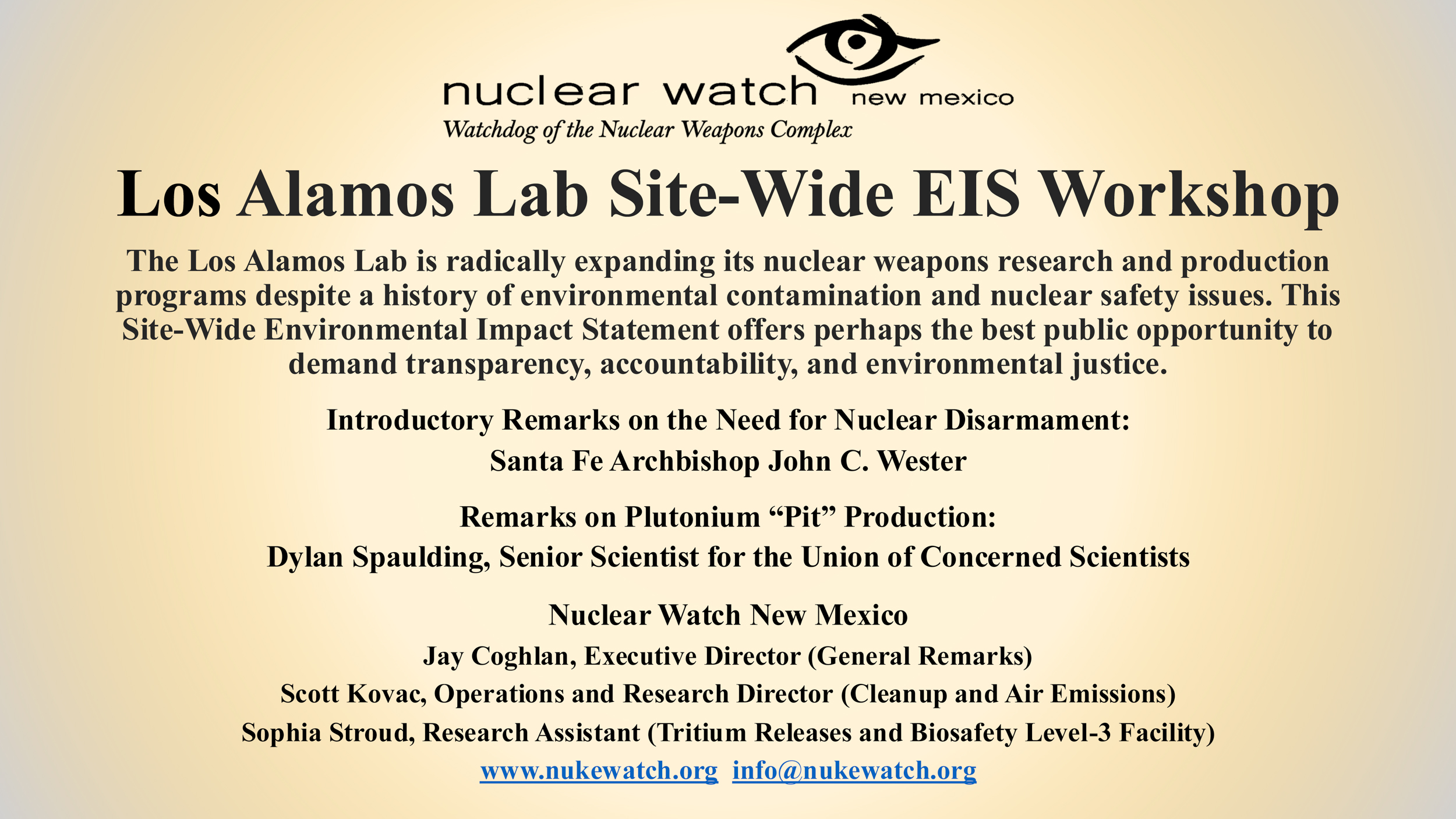 |
In Memoriam: Ken Mayers
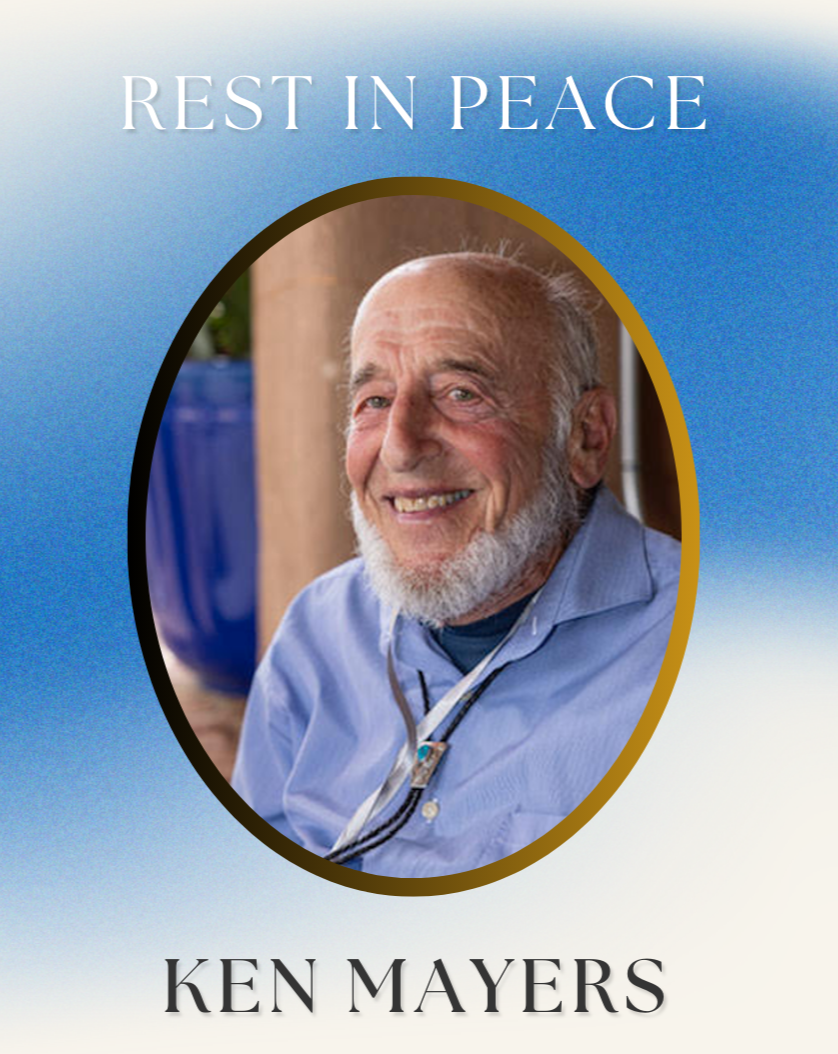 We here at NukeWatch will dearly miss Ken’s weekly presence at the corner vigil to protest Nuclear Weapons in Santa Fe.
We here at NukeWatch will dearly miss Ken’s weekly presence at the corner vigil to protest Nuclear Weapons in Santa Fe.
Locally, Ken was co-founder of the Santa Fe Chapter of Veterans for Peace and an active member of Santa Feans for Justice in Palestine. Ken worked with the local chapter of US Combatants for Peace and the Justice Council of the Unitarian Universalist Congregation in Santa Fe where he was also an enthusiastic baritone and co-founder of the NM Peace Choir.
A Celebration of Ken’s life will be held Friday, April 4 beginning at 12 noon at the corner of Sandoval and West Alameda, (Santa Fe’s weekly vigil to protest Nuclear Weapons), followed by lunch and a hybrid service at the UU Congregation, 107 West Barcelona Street, Santa Fe, NM.
For those wanting to pay tribute to Ken, please consider planting a tree through A Living Tribute (https://shop.alivingtribute.org/) or make a donation in his memory to the Santa Fe Joan Duffy Chapter of Veterans for Peace https://www.vfp-santafe.org/
Ken was a lifelong, passionate defender of peace. Read more:
Nuclear News Archive – 2022
LANL waste cleanup agreement gets chilly reception
“The 2016 consent order should be jettisoned in its entirety,” said Jay Coghlan, executive director of Nuclear Watch New Mexico. “And the fundamental principle is the state should be in the driver’s seat and not DOE.”
To back up his argument, Coghlan read some of the order’s guidelines, such as letting the federal agency set its own cleanup targets according to its budgetary constraints.
BY: SCOTT WYLAND | santafenewmexican.com
LOS ALAMOS — While some people coolly suggested a list of procedural changes, others vented Thursday about a waste cleanup agreement they say cuts out the public and gives the U.S. Energy Department too much power to call the shots.
US plutonium production plan likely to spur legal challenge
Nuclear watchdogs, government accountability advocates and other critics argue that the decision skirts requirements of the National Environmental Policy Act and a decades-old court order that included a mandate for an environmental review when the federal government embarked on plans to boost production to more than 80 of the nuclear cores a year.
BY: SUSAN MONTOYA BRYAN | apnews.com – washingtonpost.com Copyright 2020 The Associated Press
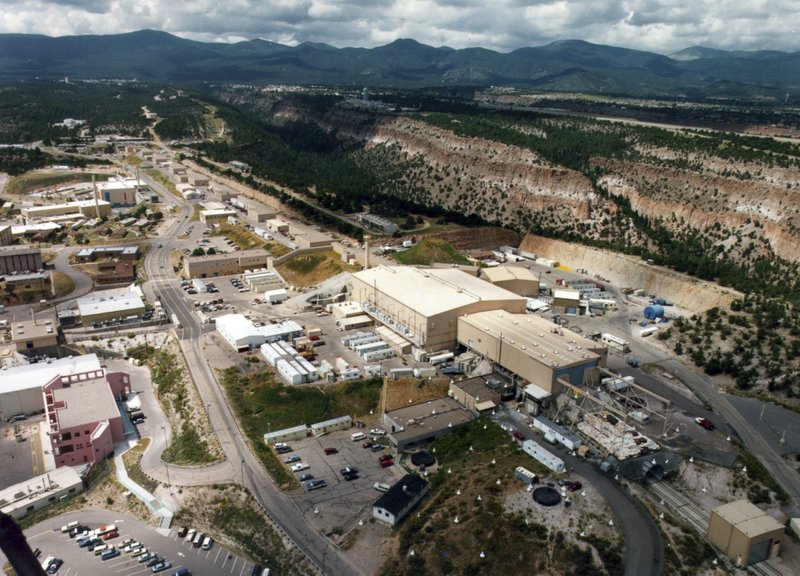
ALBUQUERQUE, N.M. — The agency that oversees the United States’ nuclear arsenal says it doesn’t need to do any broad environmental reviews of a proposal that calls for ramping up production of plutonium triggers at federal installations in New Mexico and South Carolina.
The National Nuclear Security Administration on Wednesday released a supplemental analysis related to the project, saying the determination was made after reviewing extensive documentation and public comments that were received last year.
A key component of every nuclear weapon, most of the plutonium cores in the stockpile were produced in the 1970s and 1980s, according to the nuclear agency.
Nuclear watchdogs, government accountability advocates and other critics argue that the decision skirts requirements of the National Environmental Policy Act and a decades-old court order that included a mandate for an environmental review when the federal government embarked on plans to boost production to more than 80 of the nuclear cores a year.
NNSA: No new programmatic environment study needed for plutonium pit production at LANL
“NNSA’s refusal to complete programmatic environmental review before plunging ahead with plans to more than quadruple the production authorization for plutonium bomb cores flies in the face of our country’s foundational environmental law, the National Environmental Policy Act, and a standing federal court order mandating that the government conduct such a review,” – Marylia Kelley, executive director of Tri-Valley CARES
BY: KENDRA CHAMBERLAIN | nmpoliticalreport.com
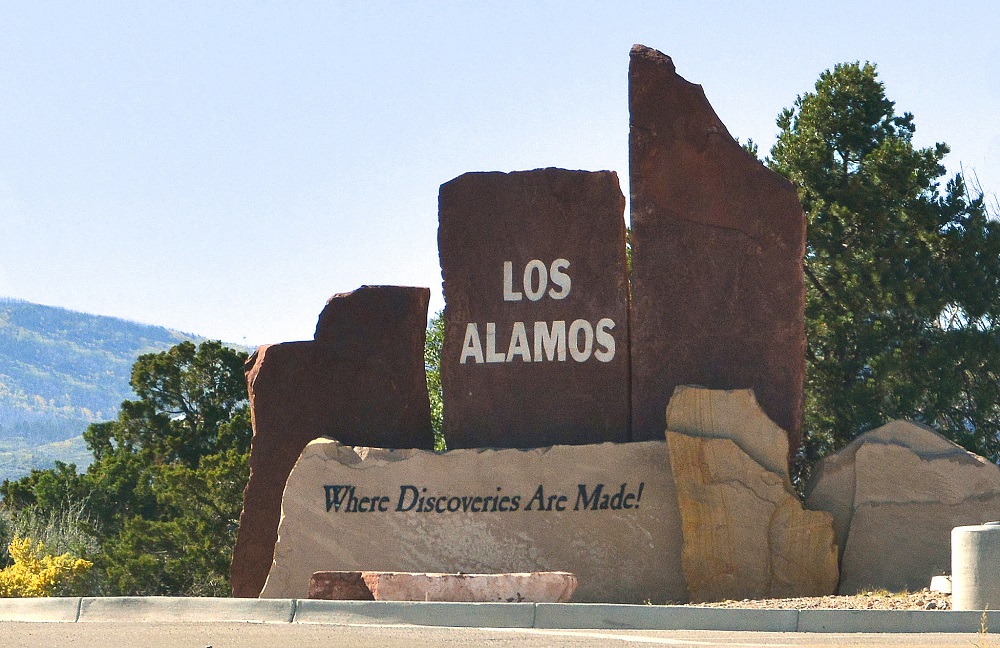
The Department of Energy’s National Nuclear Security Administration (NNSA) will not complete a programmatic study for environmental impacts of increased plutonium pit production at Los Alamos National Labs (LANL) and one other lab located in South Carolina. The decision to not do so drew criticism from Nuclear Watch NM and other groups, who argue such assessments are required by law under the National Environmental Policy Act (NEPA) and an existing court order.
Plutonium pits are the radioactive cores of nuclear warheads where the chemical reactions occur that cause the warhead to detonate. The U.S. made thousands of cores during the Cold War, but pit production has all but stopped in the last thirty years.
Now, the federal government is getting ready to ramp up pit production in order to modernize the U.S. nuclear arsenal and “assure the nation has a safe, secure and credible deterrent,” said Lisa Gordon-Hagerty, the Department of Energy Under Secretary for Nuclear Security and the NNSA Administrator, in a statement. The 2018 Nuclear Posture Review calls for at least 80 plutonium pits to be produced per year by 2030, with a target of 30 pits produced annually at LANL and 50 pits produced annually at Savannah River Site.
The Dubious Moral Justification for a Nuclear Second Strike
The aim of presenting the case for the continued possession of these terrifying weapons that hold the potential to destroy all life on earth this way seems to be to convince citizens that nuclear weapons are morally justifiable and thus somehow ‘acceptable.’
ARTICLE BY GERARD BOYCE | commondreams.org
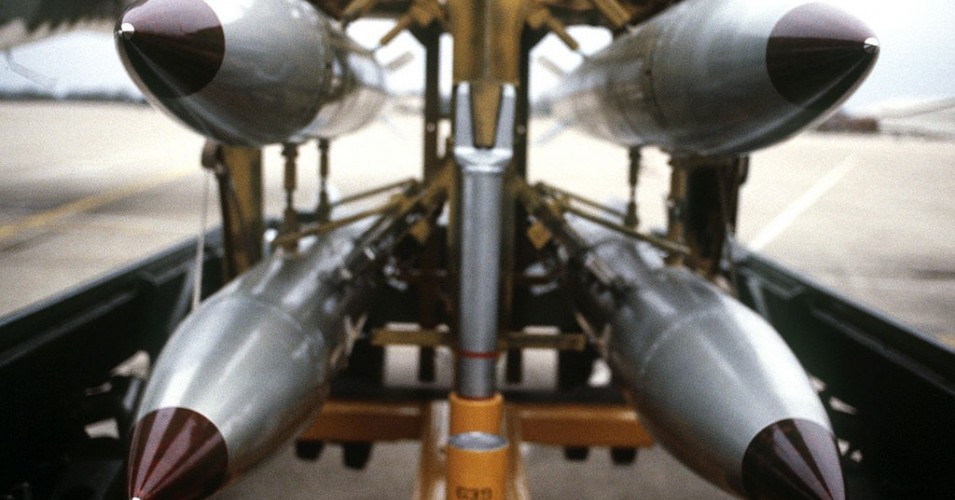
Poised as the nuclear powers appear to be to resume the nuclear arms race, leaders of these countries have been at pains to assure their countrymen and the rest of the world that, though determined to maintain and even expand their nuclear arsenals, they will only use them for the purposes of a second strike i.e. in retaliation to a nuclear first strike by a nuclear-armed belligerent. Their pledges are meant to reassure us that nuclear weapons are for defensive rather than offensive purposes. The aim of presenting the case for the continued possession of these terrifying weapons that hold the potential to destroy all life on earth this way seems to be to convince citizens that nuclear weapons are morally justifiable and thus somehow ‘acceptable’. For a number of reasons, however, a second strike may not be as morally defensible as leaders would have us believe.
Trump budget coming Feb. 10 — here’s what you can expect
BY: AARON MEHTA & JOE GOULD | defensenews.com
WASHINGTON — The Trump administration plans to submit its fiscal 2021 budget request to Congress Feb. 10, with defense spending expected to be essentially flat compared to the previous year.A spokesperson for the Office of Management and Budget confirmed to Defense News that the date for the budget submission has been locked in. The date was first reported by Politico.
President Donald Trump signed off on the FY20 budget, including $738 billion for defense, on Dec. 20, following almost three months of the government running under a continuing resolution.
The two-year budget deal from last summer called for $740 billion in defense spending for FY21, essentially flat. The budget is expected to continue the department’s focus on implementing the National Defense Strategy, which prioritizes challenging China and Russia.
New Mexico reconsidering 2016 waste agreement with LANL
The state of New Mexico is reconsidering its 2016 pact with the U.S. Department of Energy on how to regulate the cleanup of decades-old hazardous waste at Los Alamos National Laboratory.
Ryan Flynn, who became the state’s environment secretary in 2013, granted the lab 150 deadline extensions during his tenure, said Jay Coghlan, executive director of Nuclear Watch New Mexico.
Shortly after Flynn announced in 2016 that the consent order was being revised, the Energy Department reduced its top-range estimate for the long-term cleanup to $3.8 billion and said it would need at least 20 years to complete it, Coghlan said.
That reduced the yearly cleanup projection to $150 million from the earlier $250 million estimate, Coghlan said.
“It’s no coincidence that a mere few months after the 2016 consent order came out, DOE low-balled its life-cycle estimate,” he said.
BY: SCOTT WYLAND | santafenewmexican.com
The administration of Democratic Gov. Michelle Lujan Grisham wants to revisit the agreement — known as a consent order — that the state Environment Department crafted under Republican Gov. Susana Martinez to replace a more stringent 2005 version that expired at the end of 2015.
The public will have a chance to air views about the current consent order and suggest changes at a meeting Thursday at the University of New Mexico’s Los Alamos campus. The meeting is being held in response to people expressing concerns about the consent order to state regulators and legislative leaders, said Maddy Hayden, a spokeswoman for the Environment Department.
January 9th: New Mexico Environment Department to Host Los Alamos Public Meeting
Why the new US ICBMs would be too expensive even if they were free
“Experts estimate that it would take two Russian warheads to destroy with high confidence one of the 400 active US ICBMs, each armed with a single warhead. This might seem like a good deal, until you ask what the impact of 800 Russian warheads exploding on US territory would be…The long-term contamination would be about ten times greater than that from the Chernobyl accident, rendering a large swath of the Midwest uninhabitable for generations.”
BY: ROBERT J. GOLDSTON | thebulletin.org
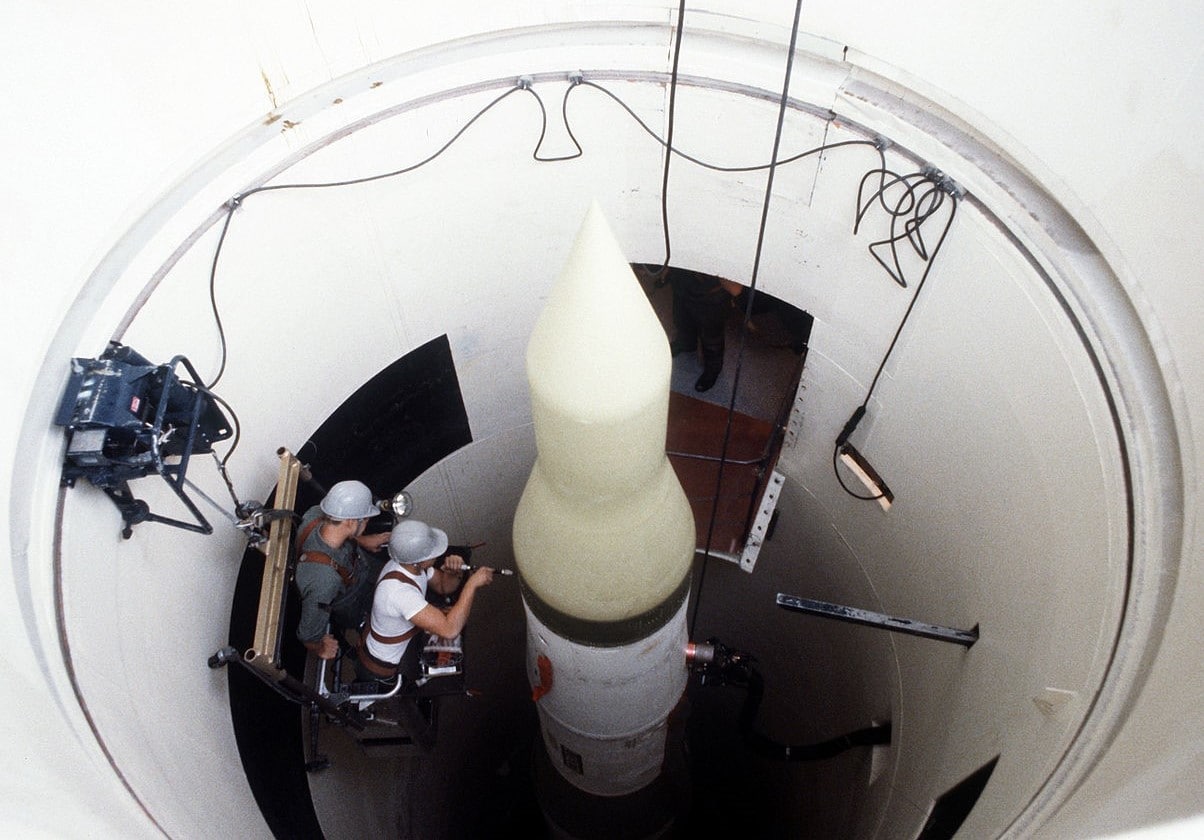
The proposed US nuclear modernization program includes replacing the 400 existing Minuteman III missiles with a new set of “Ground-Based Strategic Deterrent” missiles and their associated facilities. The cost for this modernization is very large, with an advertised price tag of $85 billion, and if history is any guide, a substantial cost escalation is likely. On the one hand, if these silo-based intercontinental ballistic missiles (ICBMs) deter attacks that would cost tens of millions of lives, then they are worth this much many times over. On the other hand, if they are more likely to cause massive numbers of human deaths, then they are immensely expensive even if they cost nothing.
The primary argument for silo-based ICBMs is that they would “sponge up” a large number of Russian warheads if the United States were attacked.
Final Supplement Analysis (SA) and Determination on Complex Transformation Supplement Environmental Impact Statement (SPEIS) for Expanded Pit Production to be Released Later This Week
The Department of Energy’s National Nuclear Security Administration (DOE/NNSA) has approved a final Supplement Analysis (SA) and determination on the Complex Transformation Supplement Environmental Impact Statement (SPEIS) which evaluated whether increasing capabilities to produce a minimum of 50 pits per year at a re-purposed Mixed-oxide Fuel Fabrication Facility (MFFF) at the Savannah River Site (SRS) and a minimum of 30 pits per year at Los Alamos National Laboratory (LANL), with additional surge capacity at each site if needed, would require the preparation of a new or supplement EIS. This SA is the programmatic, complex-wide analysis mentioned in the Notice of Intent for the site-specific SRS EIS that was published in the Federal Register (FR) on June 10, 2019, and the final of the draft SA that was released for an approximately 45-day public comment period on June 28, 2019.
It’s Been 32 Years since the Conclusion of the INF Treaty Yet Arms Control Is Still Vital
ARTICLE BY STEPHAN KIENINGER | historynewsnetwork.org
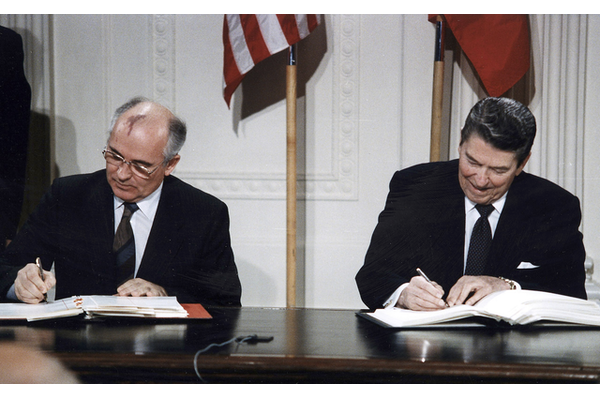
In August, the United States withdrew from the landmark INF Treaty of 1987 due to the Russian Federation’s continuing violation of the treaty and Vladimir Putin’s reckless deployment of the Russian 9M729 cruise missile. Another crucial arms control treaty, the New START agreement, is set to expire in early 2021. Recently, George Shultz and Mikhail Gorbachev called American and Russian decision makers to preserve the INF Treaty. (1)
More than thirty years ago, Shultz and Gorbachev stepped forward with President Reagan to change history’s direction. Reagan and Gorbachev signed the INF Treaty on the occasion of their historic Washington Summit on December 8, 1987. The unprecedented agreement eliminated all US and Russian missiles between the ranges of 500 to 5500 kilometers. The two countries destroyed a total of 2,692 ballistic and cruise missiles by the treaty’s deadline of June 1, 1991, with verification measures that were previously unimaginable.
If the Trump plan survives legal challenges, polluters would no longer need a permit to release contaminated water into ephemeral streams and wetlands that aren’t immediately adjacent to protected waters. This would, according to New Mexico’s Environment Department, eliminate about 40% of the state’s water pollution permits, including those held by wastewater treatment plants, hard-rock mines and coal mines.
The effect this could have on the state’s drinking water is illustrated most starkly at Los Alamos National Laboratory, the former Manhattan Project site that serves as a center of the country’s nuclear research and development.
BY: ANNA M. PHILLIPS | latimes.com
Trump’s Plans to Strip Clean Water Protections Leave New Mexico Fearing Pollution and Health Risks
The effect this could have on the state’s drinking water is illustrated most starkly at Los Alamos National Laboratory, the former Manhattan Project site that serves as a center of the country’s nuclear research and development.
The 40-square-mile site where scientists built the first atomic bomb remains contaminated from that era.
BY: Anna M. Phillips, The Los Angeles Times latimes.com Jan. 3, 2020
Twice a day, every day, Vicente Fernandez walks along the banks of the Rio Fernando, inspecting the river that has shaped his valley’s fortunes for generations.
Like his father and his grandfather before him, Fernandez is a mayordomo — the manager of a centuries-old network of irrigation ditches called acequias that divert water from the river into nearby fields. Hundreds of families in the Taos Valley rely on it to nourish their gardens and fruit trees and to replenish the aquifer they depend on for drinking water.
But the future of the Rio Fernando and its acequias is murky.
Early in the coming year, President Trump’s Environmental Protection Agency plans to roll back clean water rules, abolishing limits on how much pollution can be dumped into small streams and wetlands.
Federal data suggest 81% of streams in the Southwest would lose protections. A large share of streams in California and other Western states will be hard hit.
Nowhere are the stakes as high as in New Mexico. Environmental regulators in the state estimate that the new rule could leave 96% of the state’s waterways and wetlands unprotected from pollution from coal mines, factory waste, pesticide runoff and other sources.
And New Mexico does not have its own regulations to fill the void, which makes its waterways particularly vulnerable.
EPA: Permit will regulate polluted stormwater in Los Alamos County
The U.S. Environmental Protection Agency will require a federal pollution permit be used to regulate Los Alamos County’s contaminated stormwater, which for years has flowed into streams and the Rio Grande, a primary source of drinking water.
BY: SCOTT WYLAND | santafenewmexican.com
 Attorneys representing the Taos-based advocacy group Amigos Bravos said their client’s September lawsuit against the EPA pushed the agency to require the permitting under the Clean Water Act.
Attorneys representing the Taos-based advocacy group Amigos Bravos said their client’s September lawsuit against the EPA pushed the agency to require the permitting under the Clean Water Act.
The EPA issued preliminary findings in 2015 that showed pollutants in some parts of Los Alamos National Laboratory property and other areas of Los Alamos County far exceeded state health and water quality standards, yet the agency failed to take action, according to the Oregon-based Western Environmental Law Center.
“The EPA finally took a hard look at where these pollutants are coming from,” said Andrew Hawley, a law center attorney, in an interview. “The pollutants of concern were showing up in the tributaries going into the Rio Grande.”
EPA representatives at the regional office in Dallas couldn’t be reached Tuesday to comment on the agency’s decision or discuss the timeline for implementing the permit.
NUCLEAR WASTE: Why the drive to fund interim storage unraveled
Efforts to break through the nation’s nuclear waste logjam in the fiscal 2020 spending package fell to familiar congressional infighting despite an apparent alignment in the push for interim storage, House lawmakers said yesterday.
This is a Nuclear Weapons Offer Trump ought not to refuse
It is not very often that the Kremlin issues a transcript of remarks by President Vladimir Putin with a sentence marked in highlighter, but that’s what happened Dec. 5 when Mr. Putin met with leaders of Russia’s defense industry.
Courting Disaster: How Not to Manage Existential Threats to National Security
Washington’s pursuit of national ballistic missile defense for the last twenty years has, as much as anything else, driven Russian and Chinese strategic nuclear weapons acquisition decisions.
BY: ROBERT GALLUCCI | nationalinterest.org
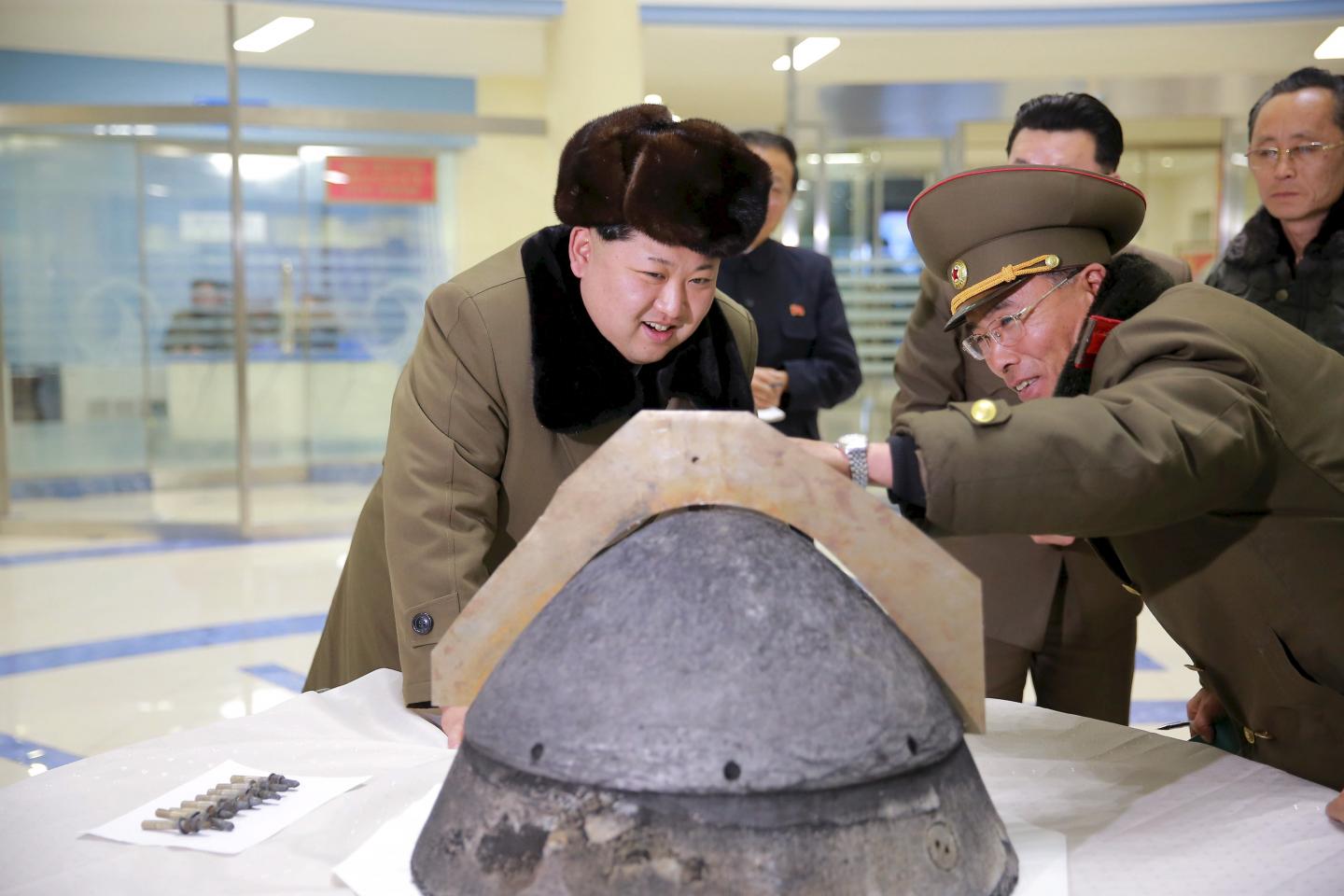
There are a small number of threats to our nation’s security, involving truly catastrophic consequences, which may be managed by good public policy. Some of these involve uncertainties over scientific or technological developments that could lead to good, as well as very bad outcomes. Think designer biology, quantum computing and artificial intelligence. But two stand out both for the certainty and magnitude of their destructive impact: climate change and nuclear weapons.
What does good public policy look like when dealing with nuclear weapons? It looks like actions that reduce uncertainty, increase transparency and security, and decrease numbers. It is called “arms control.”
NEPA transformed federal land management — and has fallen short
A look back at the ground-breaking legislation on its 50th anniversary.
BY: ADAM M. SOWARDS | defenseone.com

In late January 1969, a blowout on Unocal’s Platform A leaked 3 million gallons of crude oil into the Pacific Ocean, just 6 miles from Santa Barbara, California. The spill — at the time, the largest in U.S. history — spread over 800 square miles, coated 8 miles of beaches and killed thousands of animals. Images of the devastation shocked a public increasingly worried about the environment and helped spur Congress to pass a sweeping law aimed at preventing similar disasters in the future — the National Environmental Policy Act.
President Richard Nixon signed NEPA into law on Jan. 1, 1970, from his home office on the Pacific Coast. The signing was a fitting launch for the environmental decade of the 1970s — a time when “America pays its debt to the past by reclaiming the purity of its air, its waters, and our living environment,” as Nixon said in his signing statement. “It is literally now or never.”
Reckoning with History is an ongoing series that seeks to understand the legacies of the past and to put the West’s present moment in perspective.
Sanders Calls Out ‘Deficit Hawks’ in Both Parties Who Support $738 Billion Pentagon Budget But Claim US Can’t Afford Medicare for All
“When it comes to giving the Pentagon $738 billion—even more money than it requested—there is a deafening silence within Congress and the ruling elites about what our nation can and cannot afford.”
ARTICLE BY JAKE JOHNSON | commondreams.org
In a scathing op-ed for the Washington Post Tuesday, Sen. Bernie Sanders took aim at Republican and Democratic “deficit hawks” who claim the U.S. cannot afford to guarantee healthcare to all, make higher education tuition-free, or fund other crucial domestic priorities but have no issue with voting to hand the Pentagon $738 billion.
“When it comes to giving the Pentagon $738 billion—even more money than it requested—there is a deafening silence within Congress and the ruling elites about what our nation can and cannot afford.” — Sen. Bernie Sanders
A Gateway to Nuclear Catastrophe: Democrats Retreat on Nuclear Policy
The 2020 authorization bill fails to check Trump’s worst impulses. Over 30 progressive national security organizations sent a letter to Congress opposing the final bill as doing “almost nothing to constrain the Trump administration’s erratic and reckless foreign policy.” Senator and presidential candidate Elizabeth Warren said she would oppose the bill, calling it a “$738 billion Christmas present to giant defense contractors.”
BY: TOM Z. COLLINA | defenseone.com
Question: How do you go from a National Defense Authorization Act that in July was opposed by every House Republican to one that was approved by more GOP votes than Democratic ones and that President Donald Trump called a huge win that he cannot wait to sign?
Answer: Add Space Force and parental family leave and take out all of the progressive national security provisions.
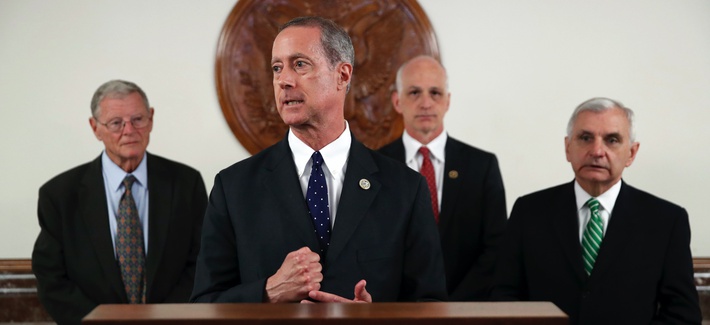
The House passed the compromise NDAA last night; President Trump has said he will sign it. This final bill is a world apart from the version passed by House Democrats in July. The House version, ably led by Rep. Adam Smith, D-Washington, chair of the House Armed Services Committee, prohibited deployment of Trump’s new “low-yield” nuclear weapon for Trident submarines, which defense experts called “a gateway to nuclear catastrophe.”
Watch the Pentagon test a previously banned ballistic missile
ARTICLE BY: AARON MEHTA | defensenews.com
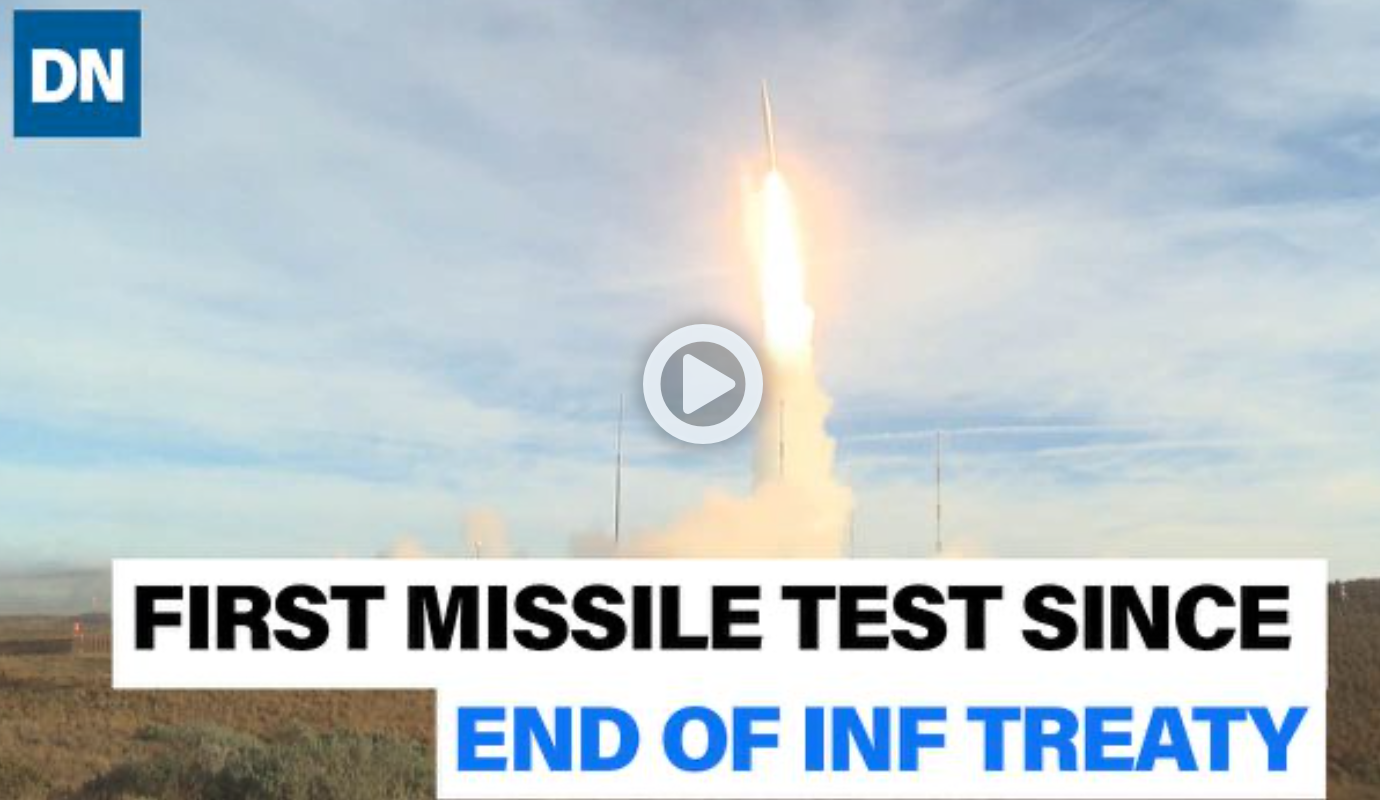
WASHINGTON — The U.S. has tested a ground-launched, intermediate-range ballistic missile with a range of more than 500 kilometers, the first such test since the country withdrew from the Intermediate-Range Nuclear Forces Treaty this year.
The test, which occurred Thursday at 8:30 a.m. PST, was configured to represent a conventional warhead. The test was anticipated for months, with Defense Department officials previously indicating they hoped to have it happen before the end of the year.
This Simulator Shows the Devastating Consequences of Global Nuclear War
Nuclear War Simulator, launching in 2020, lets the user design a plausible doomsday scenario and study the humanitarian impact. Just don’t call it a “game.”
ARTICLE BY: MATTHEW GAULT | vice.com
Full scale global nuclear war is hard to fathom. One nuclear launch could set off a chain of events that would radically alter life on the planet. Millions would die in the initial blasts and millions more would starve as the climate changed and our way of life withered. Just how are we supposed to reckon with the possibility of such wide-scale destruction?
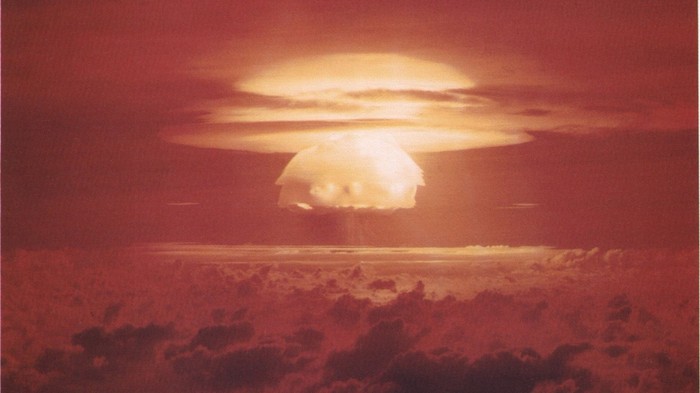
Programs like NUKEMAP let you plot individual bombs and video games like Defcon simulate the war, but neither comes close to rendering the devastation a doomsday scenario would bring. That’s what Nuclear War Simulator (NWS) is for.
Uranium contaminated property collapsing into Detroit River
Controversy continues to brew following revelations of repeated shoreline collapses into the Detroit River of a property contaminated with uranium, PCBs and other dangerous chemicals from an abandoned Manhattan Project contract facility in Detroit, Michigan.
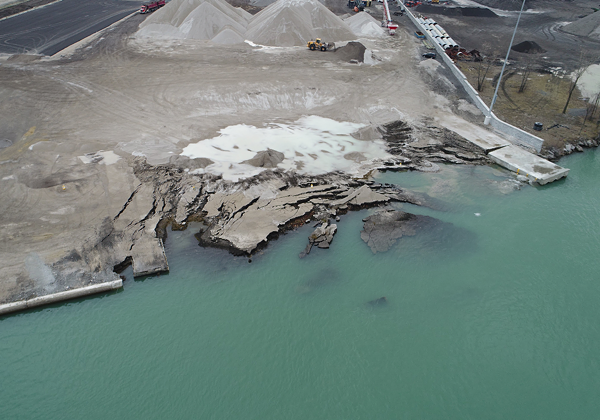
The most recent collapse into the river occurred on November 26 or 27, 2019 but was not reported until a week later with a tip off to the Windsor Star newspaper just across the river in Canada. A previous collapse into the river occurred in October 2011 did not apparently result in remediations. The old Revere Copper and Brass site, now known as Detroit Bulk Storage, was used in the 1940s to process more than a thousand tons of uranium that was rolled into fuel rods to make the fissionable material for the first atomic bombs at the end of World War II. The facility continued to operate as part of the nation’s atomic bomb assembly line well into the 1950s before winding down and eventually abandoned in 1984. It is considered just one of hundreds of nuclear weapons contractor sites that make up America’s forgotten nuclear “waste land.”
Here’s how Trump can get a win with Russia — and actually help all Americans
Extension of the New START Treaty would offer Trump an easy diplomatic win.
ARTICLE & ANALYSIS BY: MICHAEL MCFAUL | washingtonpost.com
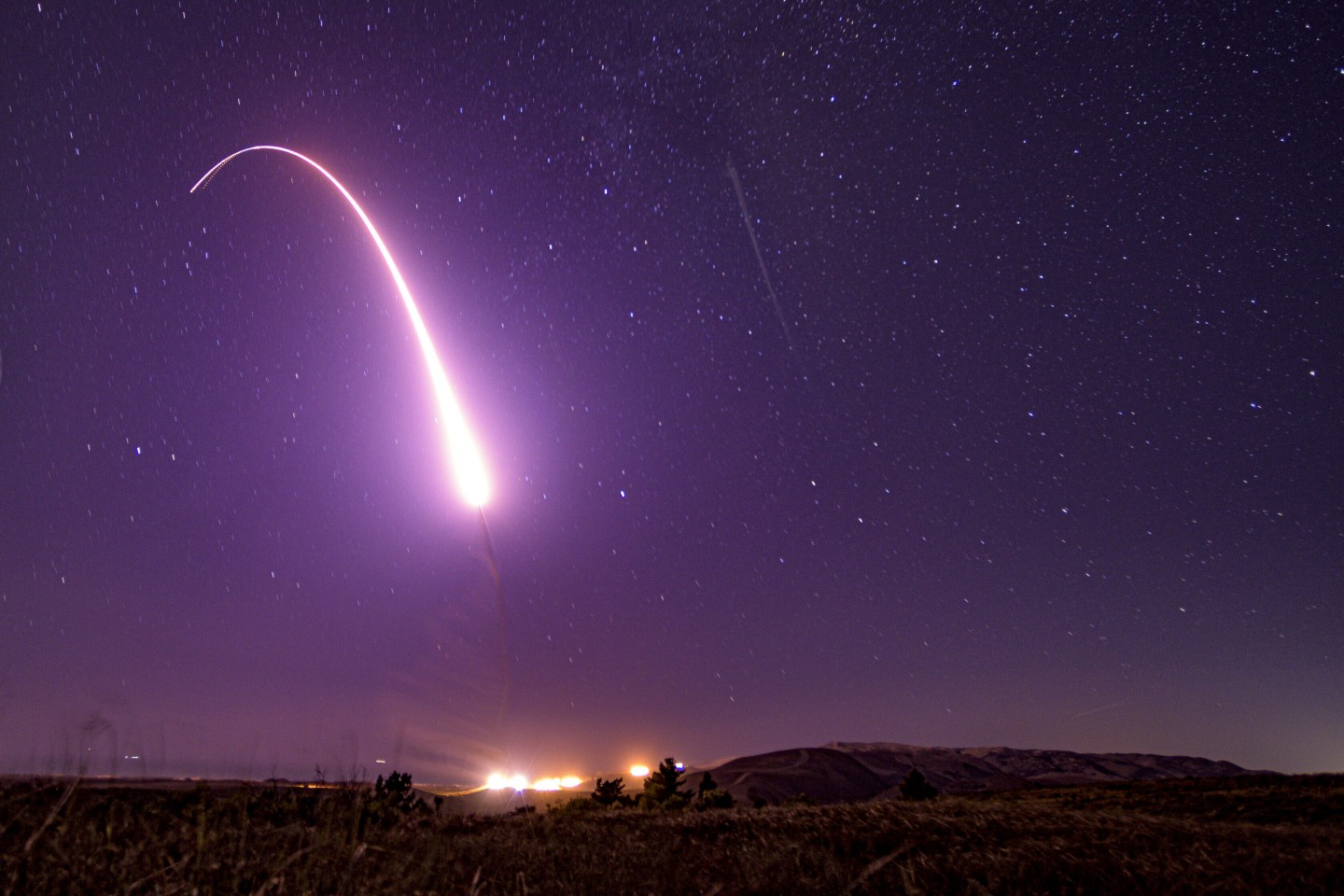
President Trump received Russian Foreign Minister Sergei Lavrov in the White House this week — a meeting that prompted considerable controversy, given the fraught backdrop of U.S.-Russia relations. Yet the coverage — additionally complicated by the impeachment proceedings taking place on Capitol Hill — almost entirely overlooked a crucial topic of the negotiations: the urgent need to keep alive a vital nuclear arms agreement.
Readouts and media reports reveal that Lavrov discussed the extension of the New Strategic Arms Reduction Treaty (START), set to expire in February 2021, with his American interlocutors. That’s the good news. The bad news is that Trump and Secretary of State Mike Pompeo both suggested that China must be included in a future strategic nuclear arms deal, hinting that they may not extend the New START Treaty without Chinese involvement.
That would be a major mistake. The United States and Russia should extend the New START Treaty, an outcome that clearly would serve U.S. national security interests. At the same time, U.S. arms control negotiators could begin discussions with their Chinese counterparts about a new, future multilateral treaty to limit the deployments of nuclear weapons. While doing so, they should recognize that China is already well below the limits on nuclear warheads and delivery vehicles specified by New START and thus need not be a party to this agreement.
But these two negotiations should be sequenced, not linked. Extend the New START Treaty with Russia first; begin strategy stability talks with Russia and China second.
Pentagon: Nuke official sexually harassed 3 women on his staff, resigns during probe
ARTICLE BY: TOM VANDEN BROOK | usatoday.com
WASHINGTON – A top Pentagon official for nuclear defense sexually harassed three women on his staff and resigned as an investigation substantiated the charges against him, the Defense Department inspector general reported Thursday.
Guy Roberts, who had served as the assistant Defense secretary for Nuclear, Chemical and Biological Defense Programs, resigned on April 2 amid a probe into allegations from three women on his staff that he had forced hugs and kisses on them and told inappropriate jokes. The inspector general’s investigation began Feb. 22.
The New START Treaty Keeps Nuclear Arsenals In Check And President Trump Must Act To Preserve It
Are the stars finally aligning for Washington and Moscow to extend the New START treaty?
ARTICLE & ANALYSIS BY: HANS KRISTENSEN & MATT KORDA | forbes.com
Nuclear arms control is reportedly on the agenda for a rush-meeting between Russian foreign minister Sergei Lavrov and US Secretary of State Mike Pompeo today. Over the past weeks, Russia had softened its preconditions for extending the New START Treaty––the only strategic arms control agreement still in place between the two nuclear superpower––while
President Donald Trump last week said that he had spoken with President Vladimir Putin and “we are – he very much wants to, and so do we, work out a treaty of some kind on nuclear weapons…”

The New START treaty limits US and Russian deployed strategic nuclear forces, and additionally facilitates inspections and exchanges of information on the status and movements of their intercontinental ballistic missiles and heavy bombers. Signed in 2010, the treaty expires in February 2021 but can be extended for another five years.There is nothing other than personalities and bad advice that is preventing Moscow and Washington from extending New START. Retaining the treaty is clearly in the interest of both countries, particularly as other arms control agreements have been abandoned and military tensions are steadily increasing.
Win Without War + 37 Orgs: NDAA a Blank Check for Trump’s Reckless Foreign Policy
WASHINGTON — 30 organizations representing a diverse set of issue areas — strengthening diplomacy, protecting migrants and refugees, preventing wars of choice, reducing the risk of nuclear catastrophe, combating corruption, promoting human rights and sound environmental policies, and standing up for democratic values — released the following statement regarding the fiscal year (FY) 2020 National Defense Authorization Act (NDAA) conference report:
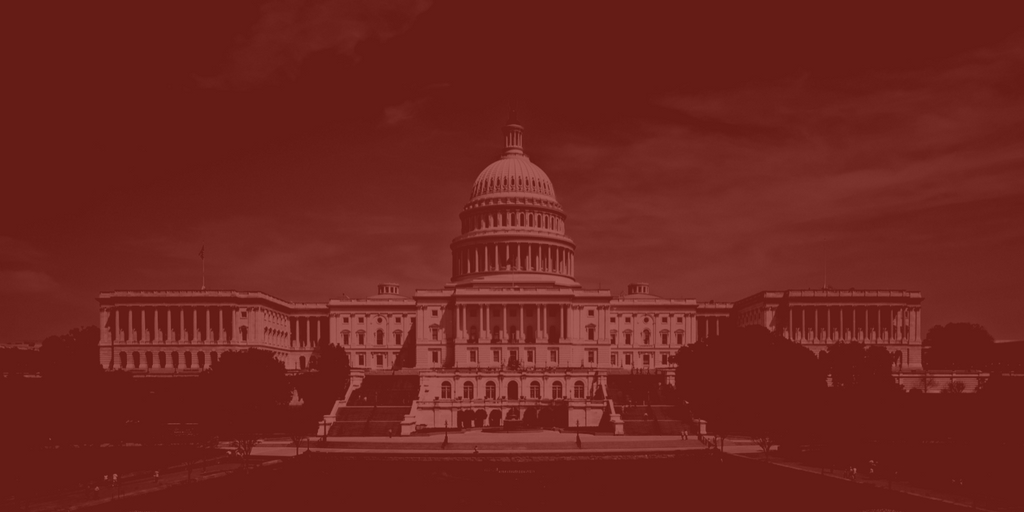
“Despite the fact that we do not all advocate on the same issues, we are compelled to state clearly in one voice: The results of negotiations for the final text of the NDAA are disastrous. The FY2020 NDAA conference report has been so severely stripped of vital House-passed provisions essential to keeping the current administration in check that it no longer represents a compromise, but a near complete capitulation.
Win Without War + 37 Orgs: NDAA a Blank Check for Trump’s Reckless Foreign Policy
The results of negotiations for the final text of the #ndaa2020 are disastrous and far removed from our vision for a just, peaceful, and democratic foreign policy. Read our statement in partnership with 30 other organizations here: https://t.co/AiO3aMlA4X
— Win Without War (@WinWithoutWar) December 10, 2019
Defense Authorization Act 2020 – Out Now
The 3488-page Conference Report is at:
https://docs.house.gov/billsthisweek/20191209/CRPT-116hrpt333.pdf
The 741-page Joint Explanatory Statement is at:
https://docs.house.gov/billsthisweek/20191209/116hrpt333-JointExplanatoryStatement.pdf
The 19-page bill summary is at:
https://rules.house.gov/sites/democrats.rules.house.gov/files/CRPT-116hrpt333-summary.pdf
On Plutonium Pit Production:
Nuclear Forces have been the cornerstone of our national defense and the conference agreement funds the President’s budget request for Nuclear National Security Administration programs, including nuclear weapons and nuclear non-proliferation activities. In addition, the FY20 NDAA supports the U.S. Strategic Command requirement to produce 80 plutonium pits per year by 2030 and doesn’t prohibit the Department from deploying low-yield nuclear weapons. It also clarifies nuclear safety authorities.
1. Page 1907 of the report defines a requirement to submit the costs of complying with cleanup agreements:
SEC. 4409. ESTIMATION OF COSTS OF MEETING DEFENSE ENVIRONMENTAL CLEANUP MILESTONES REQUIRED BY CONSENT ORDERS.
”The Secretary of Energy shall include in the budget justification materials submitted to Congress in support of the Department of Energy budget for each fiscal year (as submitted with the budget of the President under section 1105(a) of title 31, United States Code) a report on the cost, for that fiscal year and the four fiscal years following that fiscal year, of meeting milestones required by a consent order at each defense nuclear facility at which defense environmental cleanup activities are occurring. The report shall include, for each such facility—”(1) a specification of the cost of meeting such milestones during that fiscal year; and ”(2) an estimate of the cost of meeting such milestones during the four fiscal years following that fiscal year.”.
2. On page 1914 of the report: Prohibiting the DOE high-level waste interpretation from being applied (only) to Hanford.
However, the Joint Explanatory Statement (p. 492 of PDF) states: “The conferees note that the inclusion of the provision does not prejudice how to process high-level waste nor does it discourage the use of the Department of Energy’s interpretation of high-level waste in future years or at other locations.”
3. On pages 1942-51 of the report: Changes to the Defense Nuclear Facilities Safety Board (DNFSB).
Among those changes is trying to ensure DNFSB access to DOE sites. One example is that DNFSB has access to nuclear facilities “without regard to the hazard or risk category assigned to a facility by the Secretary.”
Don’t Let START Stop
Drawing upon six decades of constructive contacts between American and Russian citizens, we the participants in the latest Dartmouth Conference have decided to issue this urgent appeal to our governments, warning of the dangers of a new nuclear arms race and strongly urging both governments to act immediately to extend the New START Treaty beyond its February 2021 expiration.
ARTICLE & ANALYSIS BY: James F. Collins, David Mathews, Vitaliy Naumkin & Yury Shafranik | russiamatters.org
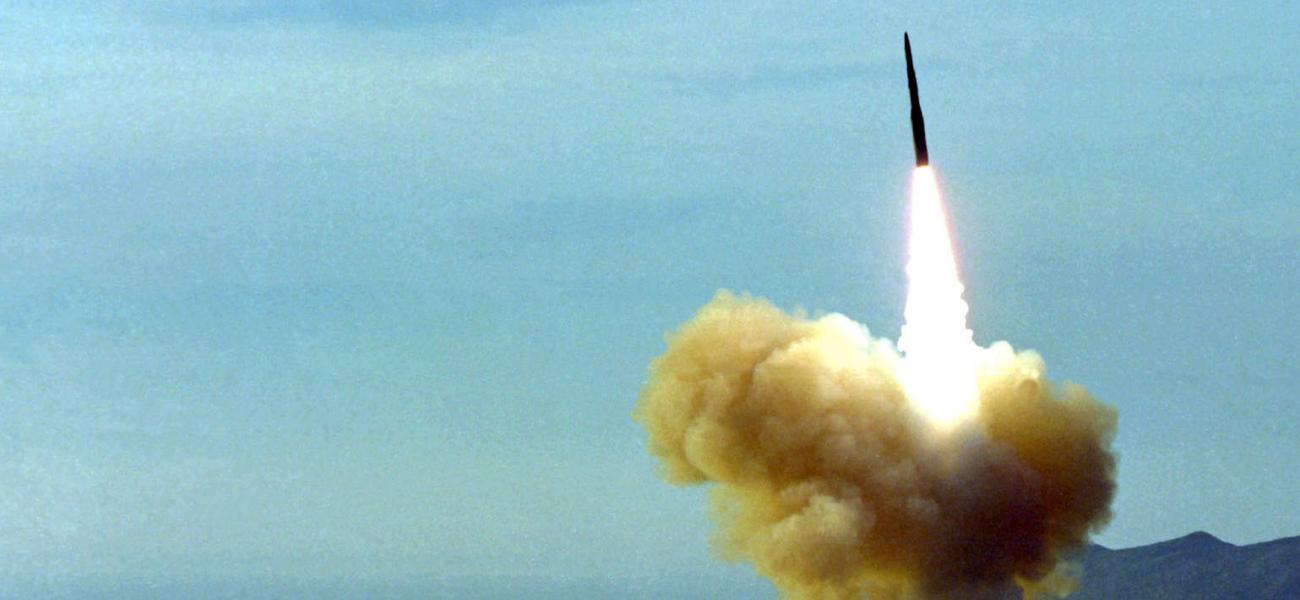
State report: LANL lost track of 250 barrels of nuke waste
The contractor that’s been in charge of Los Alamos National Laboratory’s operations for the past year lost track of 250 barrels of waste, while the company heading the legacy cleanup mislabeled and improperly stored waste containers and took months to remedy some infractions, according to the state’s yearly report on hazardous waste permit violations.
BY: SCOTT WYLAND | santafenewmexican.com
Triad National Security LLC, a consortium of nonprofits that runs the lab’s daily operations, had 19 violations of its permit from the New Mexico Environment Department. Newport News Nuclear BWXT Los Alamos, also known as N3B, which is managing a 10-year cleanup of waste generated at the lab, was cited 29 times. Triad’s most notable violation was shipping 250 barrels of mostly mixed waste to the Waste Isolation Pilot Plant in Carlsbad without tracking them. Mixed waste contains low-level radioactive waste and other hazardous materials. Inspectors found records still listed the waste at the national lab.
Mislabeled containers should be taken seriously because they can cause incidents if the contents aren’t identified, said Scott Kovac, research and operations director for Nuclear Watch New Mexico.
Lab personnel didn’t update the shipping data because they were waiting for WIPP to acknowledge it had received the waste, lab spokesman Matt Nerzig said in an emailed statement. “There was no risk to public health or safety and the inventory is now correct,” Nerzig said, adding that shipping updates now will be done when waste leaves the lab. But a watchdog group said failing to track such a high volume of waste is an egregious error that falls in line with the lab’s long history of serious missteps.
“The fact that LANL has mischaracterized, misplaced, mis-inventoried — or whatever — 250 barrels of waste is pretty astounding,” said Jay Coghlan, executive director of Nuclear Watch New Mexico. “We see mistakes being made by a new contractor. So definitely, all of this is cause for concern.”
Flammable hazard stalls LANL’s plutonium operations, waste shipments
Concerns that a calcium residue might be flammable prompted officials at Los Alamos National Laboratory to curtail plutonium operations and suspend waste shipments in early November, according to a federal report.
BY: SCOTT WYLAND | santafenewmexican.com
The lab suspended most waste generation and certification at its plutonium facility and halted all waste shipments after officials questioned the accuracy of documentation, particularly on how much calcium-and-salt residue remained in transuranic waste after processing, the Defense Nuclear Facilities Safety Board, an independent oversight panel, said in a Nov. 15 report that was publicly released Friday.
Calcium is used to help reduce oxidation in plutonium. Traces of the substance typically linger after processing, and if they are too high, they can ignite when exposed to open air, the report says.
The report didn’t say how long the operations and waste shipments were suspended. A lab spokesman could not comment Monday.
Officials from multiple agencies met in Carlsbad on Nov. 5 and 6 to discuss the hazard, including the National Nuclear Security Administration, Triad National Security LLC — the consortium that operates the lab — and N3B, a cleanup contractor. They concluded there wasn’t enough evidence of a flammable calcium level to keep operations suspended, the report said.
However, they decided to withhold shipments to the Waste Isolation Pilot Plant until further testing could be conducted, the report said.
The underground storage facility near Carlsbad forbids waste that has volatile chemicals mixed in.
WIPP became more vigilant about testing for flammable mixtures after a waste container was packaged in 2014 with a volatile blend of wheat-based kitty litter and nitrate salts, which caused it to explode and leak radiation. WIPP shut down for almost three years while it underwent a $2 billion cleanup.
Hazardous Waste Permit Renewal Begins for LANL
“If DOE and LANL continue to treat the public with disdain, it is going to be a long and difficult permitting process. All in all, this first meeting was disappointing and unproductive.” — Joni Arends, of CCNS
This week the renewal of the New Mexico Environment Department hazardous waste permit for Los Alamos National Laboratory (LANL) began in a very controlled public meeting at the Cities of Gold in Pojoaque. There was no presentation by the Department of Energy (DOE) or its contractor, Triad National Security, LLC, about their plans to renew the application. If the public had questions, they were instructed to write them on a half-sheet comment and question card. There was no explanation about if and how those comments and questions would be answered.
Listen to the full story:
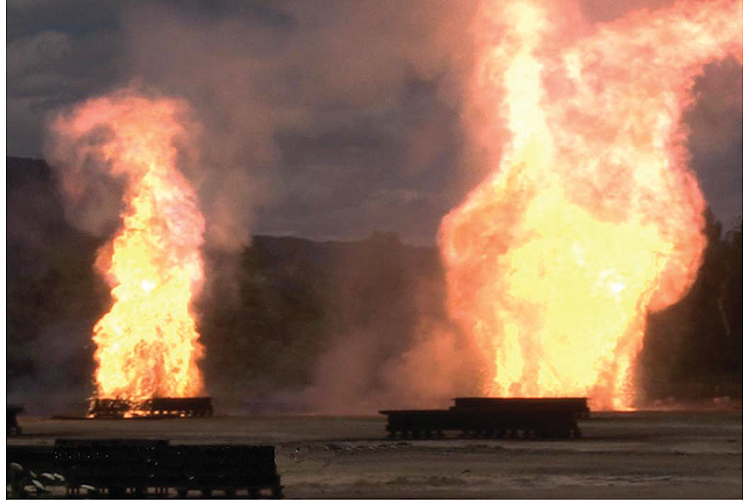
CCNS has prepared a pre-emptive sample public comment letter you can use to express what needs to be included in LANL’s permit application, including proposals to install confined burn and detonation facilities, and coming into compliance with the federal and state hazardous waste laws and regulations dealing with tank systems (that are used to treat liquid hazardous and radioactive waste) and seismic requirements. The last surface rupture on the Pajarito Plateau fault system was 1,400 years ago – thus requiring additional LANL submittals and NMED review. LANL_Permit_Renewal_App_public_comment_120519 The current ten-year LANL permit expires in late December 2020. Under the regulations, the permit application is due to the Environment Department 180 days before the permit expires, or in late June 2020. https://www.env.nm.gov/hazardous-waste/lanl-permit/ The hazardous waste permit renewal application for the Waste Isolation Pilot Plant (WIPP) is on the same timeline. https://www.env.nm.gov/hazardous-waste/wipp-permit-page/ CCNS and others have made numerous requests to both LANL and WIPP management to submit their applications in the spring of 2020 to give additional opportunity for the public to review both. At the meeting, CCNS asked when LANL would submit its application. A LANL staff member said they could not disclose the date.
Defense policy deal creates Space Force, sidesteps border wall controversy
ARTICLE BY JOE GOULD | defensenews.com
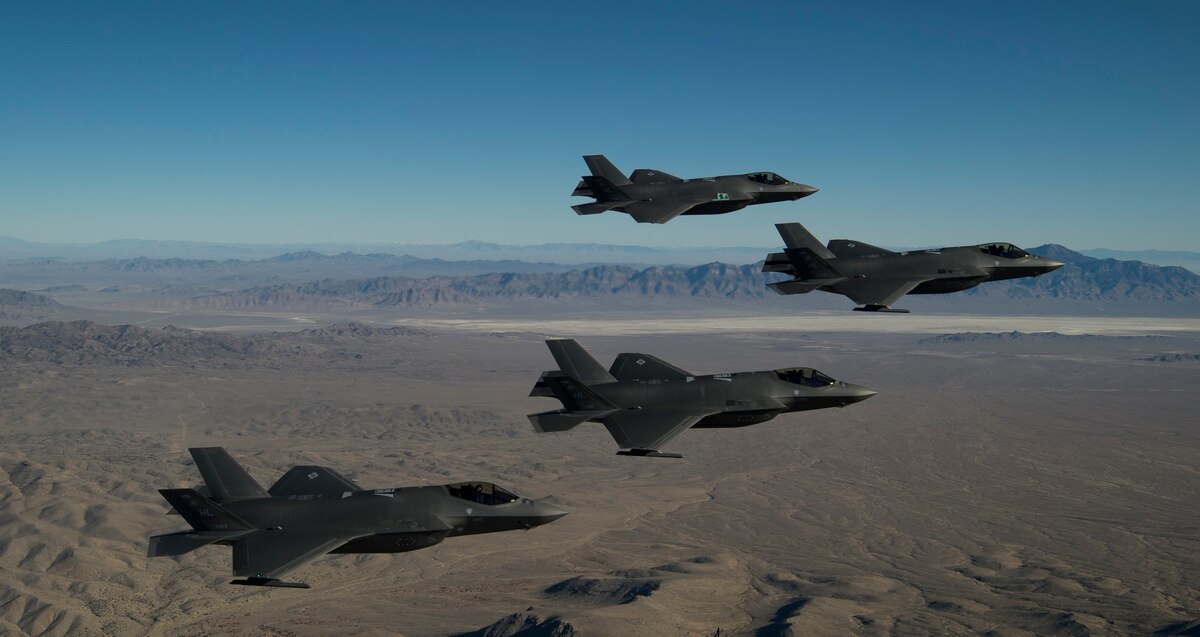
WASHINGTON ― Lawmakers involved in annual defense authorization negotiations finalized a sweeping deal late Monday that creates a new Space Force among other policies, but it dropped contentious border wall restrictions and several other provisions favored by progressives.
The 3,488-page compromise bill, which supports $738 billion in defense spending for 2020, left out limits on the border wall, low-yield nuclear weapons and the president’s authorization to wage war on Iran. However, Democratic leaders did win ― in exchange for the Space Force ― an agreement for 12 weeks of paid parental leave to millions of federal workers, which could give some House Democrats otherwise opposed to the large defense bill a reason to vote for it.
The agreement caps months of negotiations made unusually complex because Democrats control the House and Republicans the Senate. The House is expected to vote as soon as Wednesday, as Congress has only a few days to pass the bill before the House’s Christmas recess begins Thursday afternoon. President Donald Trump is expected to sign the bill into law.
CLW’s Analysis of FY Defense Authorization Conference Agreement
[embeddoc url=”https://nukewatch.org/wp-content/uploads/2019/12/CLW-FY-2020-NDAA-conference-report-analysis.pdf” width=”100%” height=”60%” download=”all” viewer=”google”]
SSFL stalemate
An informational meeting on Nov. 20 turned confrontational
ARTICLE BY MELISSA SIMON | simivalleyacorn.com
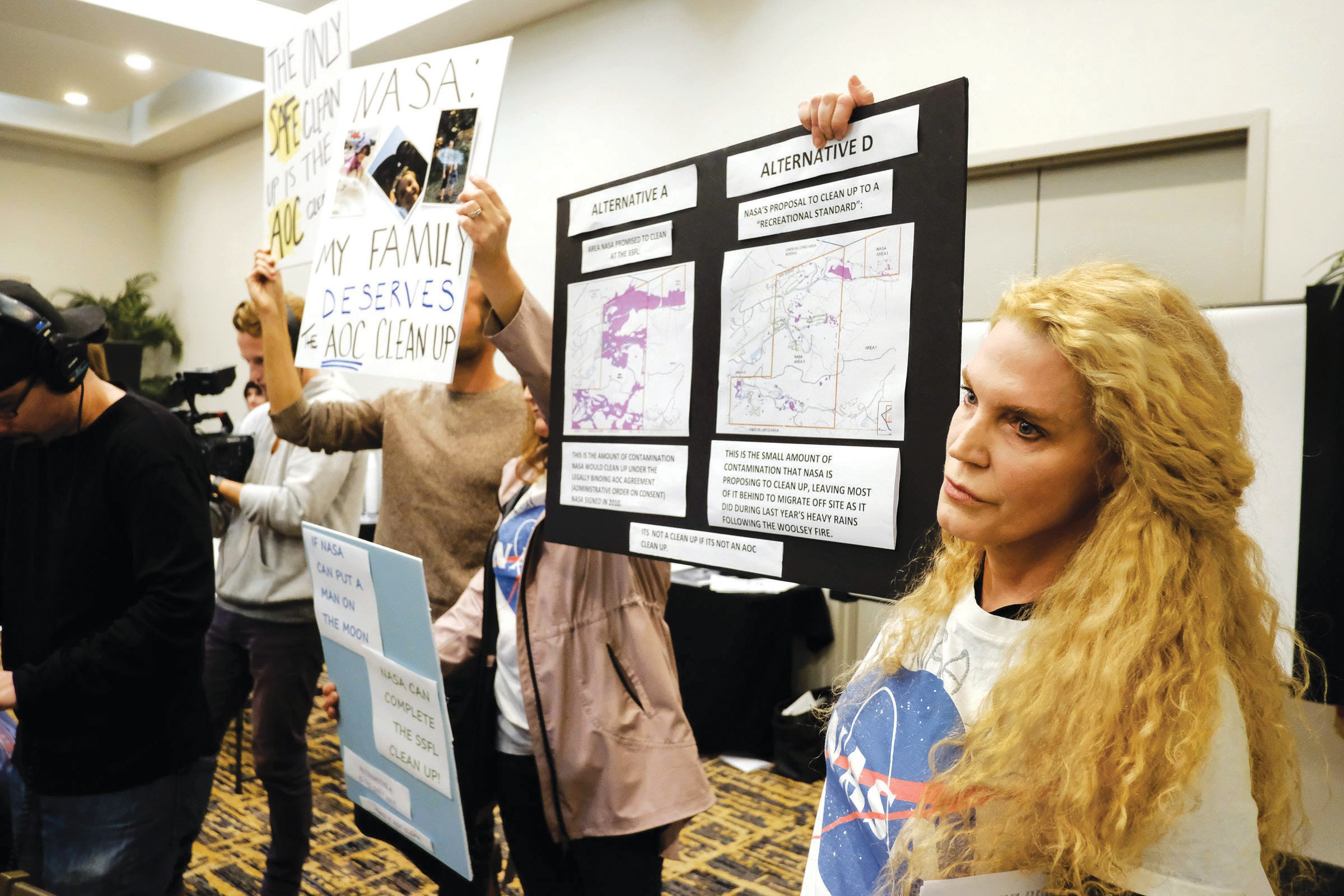
A public meeting regarding the long-delayed cleanup at the Santa Susana Field Lab last week got heated when police were called in to remove one of the activists waiting to give feedback on a recently released environmental impact study.
Dan Hirsch, president of the nonprofit nuclear policy organization Committee to Bridge the Gap, had planned to present a slideshow while giving his three minutes of testimony during a Nov. 20 event held by NASA at Best Western Posada Royale Hotel in Simi Valley. The three-minute time was allotted to anyone who chose to share comments related to the field lab.
But the longtime site cleanup activist said he was met with opposition from NASA officials, who physically tried to block the setup of a projector that he brought with him and then later called police to have him removed from the venue.
The confrontation lasted about 15 minutes, he said. And while he was waiting quietly in line to give his comments, Hirsch said police showed up and asked him to leave voluntarily or he would be charged with trespassing.
Fireworks at NASA meeting for cleaning up nuke meltdown at Santa Susana Field Lab
The 2,850-acre field lab in unincorporated hills just southeast of Simi Valley experienced the partial nuclear meltdown in 1959 when it was the Rocketdyne/Atomics International rocket engine test and nuclear facility. The site also experienced other chemical and radioactive contamination over the years.
ARTICLE BY MIKE HARRIS | vcstar.com
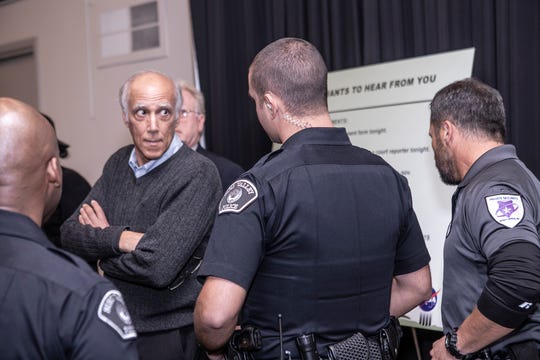
Fireworks erupted this week at a NASA public meeting on the much-delayed cleanup of a 1959 partial nuclear meltdown at the Santa Susana Field Laboratory outside Simi Valley.
Longtime cleanup activist Dan Hirsch, president of the Committee to Bridge the Gap, a nonprofit nuclear policy organization, said he was asked by Simi Valley police to leave Wednesday night’s meeting at the Best Western Posada Royale after trying unsuccessfully to present a slide show.
The meeting was held to allow the public to comment on NASA’s recently released Draft Supplemental Environmental Impact Statement regarding cleaning up its portion of the field lab site.
Sandia Labs Appoints Director
The next director of Sandia National Laboratories has ties to both national laboratories in New Mexico.
ARTICLE BY: SCOTT TURNER
abqjournal.com © 2019 Albuquerque Journal
James S. Peery will succeed Stephen Younger who is retiring at the end of the year. He will become the 16th laboratories director in Sandia’s 70-year history and will officially lead the labs beginning Jan. 1.
Peery, 57, worked at Sandia from 1990 to 2002 and then again from 2007 to 2015. He has served in multiple leadership capacities at Sandia and Los Alamos national laboratories during his career. He currently serves as Associate Laboratory Director of National Security Sciences at Oak Ridge National Laboratory in Tennessee.
Peery’s appointment was announced Monday afternoon
LANL Proposes Satellite “Campus” in Santa Fe
Santa Fe, NM – Today, the Santa Fe New Mexican newspaper reported:
“Santa Fe city leaders asked for developers’ ideas on what to do with the city-owned midtown campus…The National Nuclear Security Administration [NNSA], which administers the Los Alamos National Laboratory management and operating contract, submitted a master developer proposal to build an open-campus environment with administrative offices, sustainable green spaces, engineering space, light manufacturing, training facilities and research and development…
[A NNSA spokesperson said] “LANL is undergoing unprecedented growth and expects to hire more than 1,000 new personnel annually for the next several years. Having a new campus — midway between New Mexico’s two national laboratories [LANL and Sandia]— to house professional staff, scientists, and engineers in partnership with the city of Santa Fe — would be very beneficial.” ”
POPE FRANCES CALLS FOR NUCLEAR WEAPONS ABOLITION
Santa Fe, NM – Today, Pope Francis called for the global abolition of nuclear weapons while paying homage to the victims of the bombings of Hiroshima and Nagasaki. Those two cities were both destroyed by atomic weapons designed and produced by the Los Alamos National Laboratory, located in northern New Mexico’s Santa Fe Catholic Archdiocese.
The Holy Father declared:
“With deep conviction I wish once more to declare that the use of atomic energy for purposes of war is today, more than ever, a crime not only against the dignity of human beings but against any possible future for our common home. The use of atomic energy for purposes of war is immoral, just as the possessing of nuclear weapons is immoral, as I already said two years ago. We will be judged on this. Future generations will rise to condemn our failure if we spoke of peace but did not act to bring it about among the peoples of the earth. How can we speak of peace even as we build terrifying new weapons of war?”
Nuclear News Archives – 2021
Nothing Found
It seems we can’t find what you’re looking for. Perhaps searching can help.


